This week, babies were born and lettuce was thrown out. Here’s a look at some top Search trends from the week, with data from theGoogle News Lab.
What’s in a name?
A lot, if you’re a Royal. After Prince William and Kate Middleton welcomed a son into the world this week, searches for “name of new royal baby” went up more than 3,000 percent. The newly-named Prince Louis’s siblings were also of interest—searches for “Prince George full name” went up 1,000 percent, and “Who is Princess Charlotte named after?” was also a trending question.Trying to conjure up some tickets
Muggles and wizards alike are wondering “How much are tickets to Harry Potter and the Cursed Child?” (we’re guessing it’ll be a lot of Galleons). They may be ditching Orlando for New York—the play was more popular in Search than the Wizarding World of Harry Potter, but not quite as popular as “Summer: The Donna Summer Musical,” which was the most searched Broadway play this week.More baby news
An image of a shirtless Dwayne “The Rock” Johnson holding his newborn baby girl went viral this week, and people oooh-ed and aaah-ed all over Search (interest in “the rock new baby” went up 2,750 percent). This was after he got a heartfelt invitation to prom from a superfan in Minnesota, which caused searches for “the rock prom” to go up 1,850 percent. Quite the week!Lettuce warn you
Search questions are a mixed bag, but here’s one that stood out this week: “Is it safe to eat romaine lettuce yet?” If you’d like some side trends with your salad, there’s been a 1,000 percent increase in searches for “ecoli virus,” and the most searches for “e. coli” are coming from Alaska, Montana and Idaho.An ending to marvel at
“The Avengers: Infinity War” hit the big screen this week, and there’s one thing on everyone’s mind: “Who dies in Infinity War?” Searches for “infinity war spoilers who dies” went up nearly 1,000 percent this week. We won’t spoil anything, but according to one top Search question—”How many post-credit scenes are there in Infinity War?”—you should stick around until the very end.
Your family is probably tired of hearing the same old stories about your high school glory days, or about that one time you rolled five Yahtzees in a row at game night. So the next time you’re in need of a story (probably today—it’s National Tell a Story Day!), the Google Assistant has some good ones to share. Gather ‘round:
- For the classics like “Little Red Riding Hood,” “Cinderella” and “Sleeping Beauty,” say “Hey Google, tell me a story.”
- To hear short stories from NPR told by real people across the United States, say “Hey Google, tell me a StoryCorps story”
- When you say “Hey Google, tell me a story about motherhood,” you’ll hear beautiful, two-minute interviews between mothers and their children. Keep that one in mind in a few weeks for Mother’s Day.
- If you want a fun, interactive adventure with the kids, get Mickey Mouse involved with “Hey Google, talk to Mickey Mouse Story Time.” Or Lightning McQueen can put story time into high gear–just say, “Hey Google, talk to Cars Adventure.”
- For times when you want five lines and some rhymes, say “Hey Google, give me a limerick.”
Whether you’re into mountain landscapes or city skyscrapers, Pixel photographers take you out on some incredible adventures this week. Sit back, relax, and let #teampixel transport you to a blue paradise, a reflective lake, and even an underwater swim with jellyfish.
The next time you're on an outdoor adventure, tag your Pixel photos with #teampixel and you might be featured on @google or The Keyword.
Editor’s Note: Last summer, we announced Google’s support of the Dynamic Learning Project—a pilot program from Digital Promise that places technology coaches in 50 high-need schools across the country. Coach Caree Rahberg is helping her fellow educators at Liberty Junior High School in Texas learn how to engage their students with technology. In this post, she shares how she has helped spark a culture of innovation and growth at the school.
This fall, students at my school officially got their own laptops. It signified a shift in our school culture, and we wanted to make sure that our teachers could meaningfully use this technology in their lessons. Our teachers needed someone in their corner who could encourage them, guide them, and celebrate their progress. Just like our students are supported by our teachers, our teachers needed a coach of their own.
Thanks to the Dynamic Learning Project, I was able to become that coach . I’m so grateful to have this opportunity support teachers on their journeys with technology, and we’ve achieved so much together in our first year. Here are a few things I’ve learned in my time with the Dynamic Learning Project.
Thanks to the Dynamic Learning Project, I was able to become that coach . I’m so grateful to have this opportunity support teachers on their journeys with technology, and we’ve achieved so much together in our first year. Here are a few things I’ve learned in my time with the Dynamic Learning Project.
1. It's all about the relationships.
As I frequently remind myself, none of us is better alone. Exchanging ideas and building relationships between coaches, veteran teachers, new teachers, and researchers helps us all uncover better ways to serve our students. When we create trusting communities where we can transparently share what we’ve learned—the good and the bad—we set the foundation for success.2. Celebrate your teachers as the heroes.
Teachers put in so much work behind the scenes—during lunch breaks, and after school hours—so it’s important to publicly celebrate their success in front of their students and school community. When our students see how hard our teachers are working, they feel excited and proud. Here’s one example that always makes me smile.One day, I visited a teacher in her classroom. Afterward, I told her that the students had shared how much they enjoyed her recent lesson and were still talking about it throughout the day. Overhearing our conversation, her students were curious. I told them their teacher was asked to present her latest digital teaching technique during our regular staff meeting. Her students were ecstatic for her! They were proud to see her progress and cheered.
3. Listen to your students
I’ve always encouraged our educators to let students bring their own approach to their use of technology. One story sticks out to me in particular.One of my teachers uses an app to track and celebrate positive student behavior, and students love earning points and selecting prizes out of the "prize box."
The moment that brought her the most joy was when a student who collected the most positive behavior points chose an unexpected prize. Rather than selecting one from the box, he asked, "Could you call my mom and tell her the good job I’m doing?" It was music to her ears—he didn’t care about the prizes; he wanted positive affirmation. This showed us that technology is at its best when teachers modify it to respond to their students’ needs.
My time as a Dynamic Learning Project coach has reminded me that all learners deserve supportive coaches, especially teachers themselves. At Liberty Junior High School, we’re creating a school-wide exhibit that celebrates teachers who have participated in this program. It is my hope that when future educators see their peers’ examples, they’ll be inspired by their predecessors’ efforts and successes. I hope that these keys to success inspire any coach who is working to support their fellow educators. It's been a thrilling journey, and I can't wait to see where the DLP Coaching program goes next!
My time as a Dynamic Learning Project coach has reminded me that all learners deserve supportive coaches, especially teachers themselves. At Liberty Junior High School, we’re creating a school-wide exhibit that celebrates teachers who have participated in this program. It is my hope that when future educators see their peers’ examples, they’ll be inspired by their predecessors’ efforts and successes. I hope that these keys to success inspire any coach who is working to support their fellow educators. It's been a thrilling journey, and I can't wait to see where the DLP Coaching program goes next!
Editor’s Note: When you use a Google product, you might not realize that there’s an entire team of people who have carefully designed everything from the icons you see to the button that you click. In our latest installment of the She Word—a Keyword series all about dynamic and creative women at Google—we talked to Catherine Courage, Vice President of User Experience (UX) who “puts herself in other people’s shoes” to design the best possible products for them.
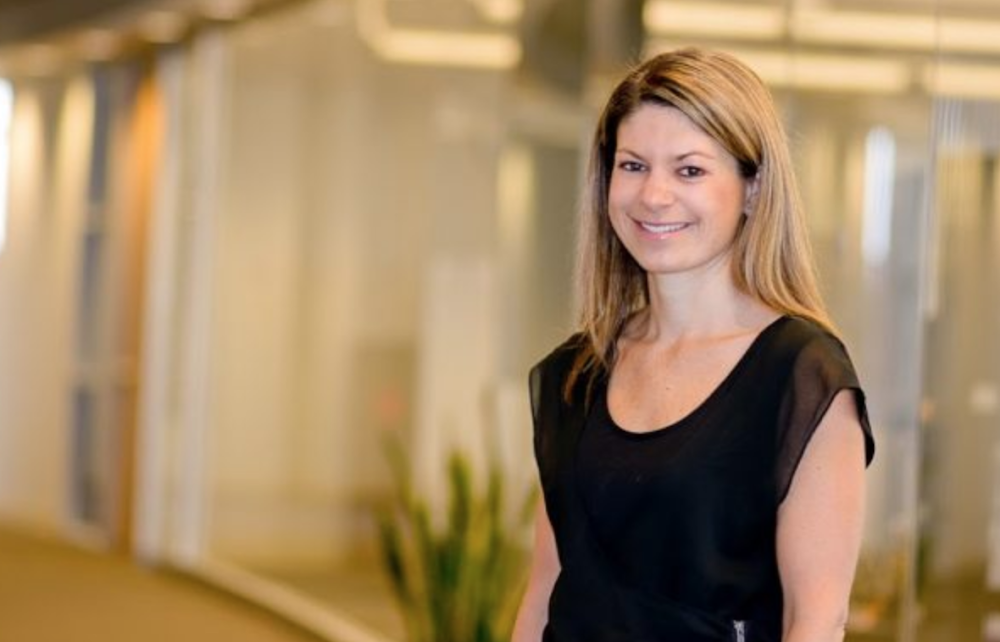
How do you explain your job at a dinner party?
I lead a global user experience (UX) team comprised of designers, researchers, writers, and engineers. The role of UX is to listen to our users, and then design experiences that meet their needs. We design products for publishers and advertisers to grow their businesses, like local services, which helps small businesses connect with customers. We’re also behind the apps that you use to shop or book flights, like Google Trips.
How did you get into UX?I entered UX through research—my job was to observe how people use a product, and figure out how the design of the product can better serve their needs. I focused on putting myself in other people’s shoes, and I carry that focus to my current job too.
What’s something your team is working on that you’re excited about?We’re doing a lot of great work with machine learning. For example, AdSense (Google’s product that lets website owners earn money by showing ads), uses machine learning to learn about a site’s content and then suggest the best places to show ads that aren’t annoying and are more likely to be relevant.
How has the role of designers changed over the past decade?A decade ago, design was associated primarily with beauty. But today it’s seen as a critical part of a successful business. Companies realize they need to attract and retain loyal users—people won’t stick around and use a poorly-designed site or app. These days, an established design team is as standard as a product management or engineering team. We’re seeing more founders, CEOs, or top executives with backgrounds in design.
What do you want to get better at?I’d like to bring more empathy to my leadership style. When you manage a global team of over 500, it’s easy to focus on the operations of the machine and lose sight of the amazing people who make it work. It’s important to spend time celebrating our achievements (before we go on to the next thing). Team wellness is a big priority, and part of wellness is pausing to acknowledge the people who make us successful.
Have you read or watched anything remarkable lately?I was lucky to see Michelle Obama speak recently about how she’s committed to building a bench of future leaders. I was struck by her humility and authenticity—she makes you feel like she’s a close girlfriend. It was fun hearing her poke fun at Barack, reminding us that he’s a human being like the rest of us, imperfections and all.
What do you like to do during your free time?I love the outdoors and physical activity, and when I do more of those things, I’m better at my job. It allows me to clear my head and decompress. I often solve some of my toughest problems when I am out for a run or a ride. This year, I’m training to run the New York City marathon!
I lead a global user experience (UX) team comprised of designers, researchers, writers, and engineers. The role of UX is to listen to our users, and then design experiences that meet their needs. We design products for publishers and advertisers to grow their businesses, like local services, which helps small businesses connect with customers. We’re also behind the apps that you use to shop or book flights, like Google Trips.
How did you get into UX?I entered UX through research—my job was to observe how people use a product, and figure out how the design of the product can better serve their needs. I focused on putting myself in other people’s shoes, and I carry that focus to my current job too.
What’s something your team is working on that you’re excited about?We’re doing a lot of great work with machine learning. For example, AdSense (Google’s product that lets website owners earn money by showing ads), uses machine learning to learn about a site’s content and then suggest the best places to show ads that aren’t annoying and are more likely to be relevant.
How has the role of designers changed over the past decade?A decade ago, design was associated primarily with beauty. But today it’s seen as a critical part of a successful business. Companies realize they need to attract and retain loyal users—people won’t stick around and use a poorly-designed site or app. These days, an established design team is as standard as a product management or engineering team. We’re seeing more founders, CEOs, or top executives with backgrounds in design.
What do you want to get better at?I’d like to bring more empathy to my leadership style. When you manage a global team of over 500, it’s easy to focus on the operations of the machine and lose sight of the amazing people who make it work. It’s important to spend time celebrating our achievements (before we go on to the next thing). Team wellness is a big priority, and part of wellness is pausing to acknowledge the people who make us successful.
Have you read or watched anything remarkable lately?I was lucky to see Michelle Obama speak recently about how she’s committed to building a bench of future leaders. I was struck by her humility and authenticity—she makes you feel like she’s a close girlfriend. It was fun hearing her poke fun at Barack, reminding us that he’s a human being like the rest of us, imperfections and all.
What do you like to do during your free time?I love the outdoors and physical activity, and when I do more of those things, I’m better at my job. It allows me to clear my head and decompress. I often solve some of my toughest problems when I am out for a run or a ride. This year, I’m training to run the New York City marathon!
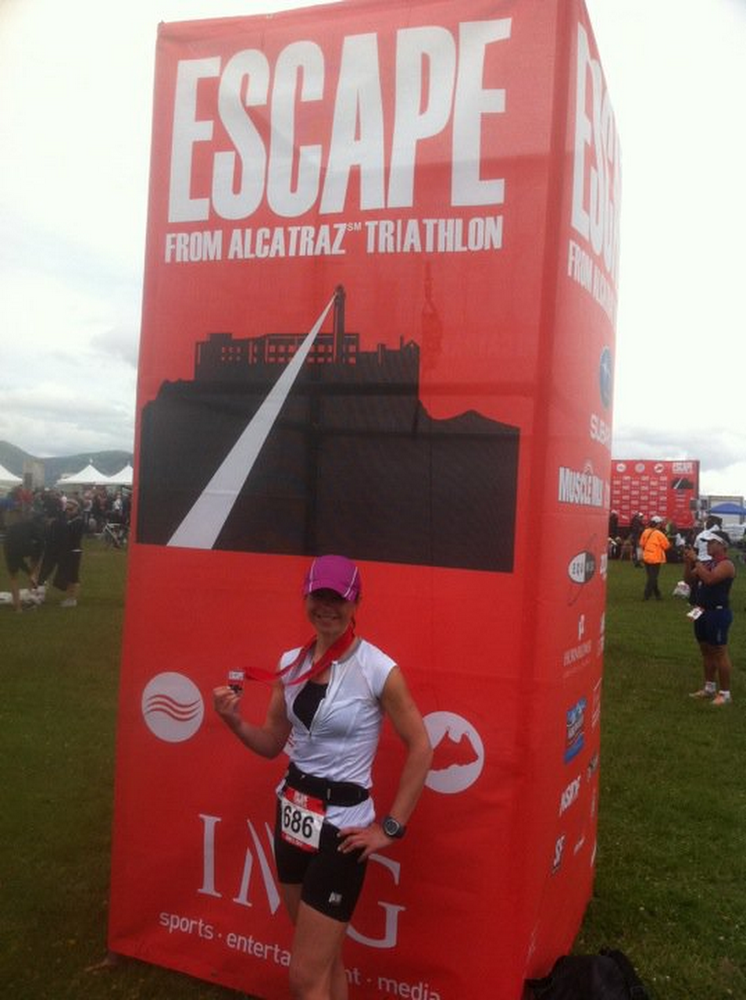
Here's Catherine at the "Escape from Alcatraz" triathlon in San Francisco.
What’s one habit that makes you successful?
I listen, ask a lot of questions, and try not to make assumptions. I’m a strong believer in asking for help (even today as a senior executive). Often people see this as a weakness, but I see it as the reverse. People are flattered when you ask for their advice and perspective.
What advice do you have for women starting out in their careers?
Embrace fear, rather than letting it hold you back. I love the quote “Growth and comfort do not coexist.” The twinge of doubt is often a sign that you’re pushing to the next level. The potential rewards of taking a chance are tremendous, and far more significant than the fear and risk you may be feeling.
Who has been a strong female influence in your life?My mother–who completed her PhD while raising three children—and is one of four sisters, so I’ve been surrounded by female leaders since birth. I grew up believing I could do anything I wanted!
I listen, ask a lot of questions, and try not to make assumptions. I’m a strong believer in asking for help (even today as a senior executive). Often people see this as a weakness, but I see it as the reverse. People are flattered when you ask for their advice and perspective.
What advice do you have for women starting out in their careers?
Embrace fear, rather than letting it hold you back. I love the quote “Growth and comfort do not coexist.” The twinge of doubt is often a sign that you’re pushing to the next level. The potential rewards of taking a chance are tremendous, and far more significant than the fear and risk you may be feeling.
Who has been a strong female influence in your life?My mother–who completed her PhD while raising three children—and is one of four sisters, so I’ve been surrounded by female leaders since birth. I grew up believing I could do anything I wanted!
As new technologies change the way people do their jobs or run their businesses, YouTube can help them acquire new skills to take advantage of the opportunities ahead.
Video is much more than just a source of entertainment, it’s also a powerful medium for learning. YouTube has a wealth of resources to help people advance their careers, prepare for new jobs or grow their businesses. More than 500 million learning-related videos are viewed on the platform every day. These videos are made and shared by a highly-motivated group of creators, such as Linda Raynier, whose videos teach job seekers how to nail aninterview or write a resume that gets noticed; or Vanessa Van Edwards, who helps people master soft skills like how to use body language in an interview or communicate a great elevator pitch. Thanks to creators like Linda and Vanessa, people can learn new skills for free and engage with a YouTube community of experts for valuable support.
In the ten European countries covered in the research, 64 percent of respondents felt that YouTube helps them learn new skills that enable personal or professional advancement, making it the highest-rated channel of those included in the survey. YouTube scores highly on this measure for both men (62 percent) and women (66 percent), and across all age groups, at least 50 percent of respondents agreed with the statement.
Video is much more than just a source of entertainment, it’s also a powerful medium for learning. YouTube has a wealth of resources to help people advance their careers, prepare for new jobs or grow their businesses. More than 500 million learning-related videos are viewed on the platform every day. These videos are made and shared by a highly-motivated group of creators, such as Linda Raynier, whose videos teach job seekers how to nail aninterview or write a resume that gets noticed; or Vanessa Van Edwards, who helps people master soft skills like how to use body language in an interview or communicate a great elevator pitch. Thanks to creators like Linda and Vanessa, people can learn new skills for free and engage with a YouTube community of experts for valuable support.
Finding out the facts
Together with brand consultancy Flamingo, we recently surveyed internet users to discover what they think of YouTube and and how it helps them learn new skills.In the ten European countries covered in the research, 64 percent of respondents felt that YouTube helps them learn new skills that enable personal or professional advancement, making it the highest-rated channel of those included in the survey. YouTube scores highly on this measure for both men (62 percent) and women (66 percent), and across all age groups, at least 50 percent of respondents agreed with the statement.
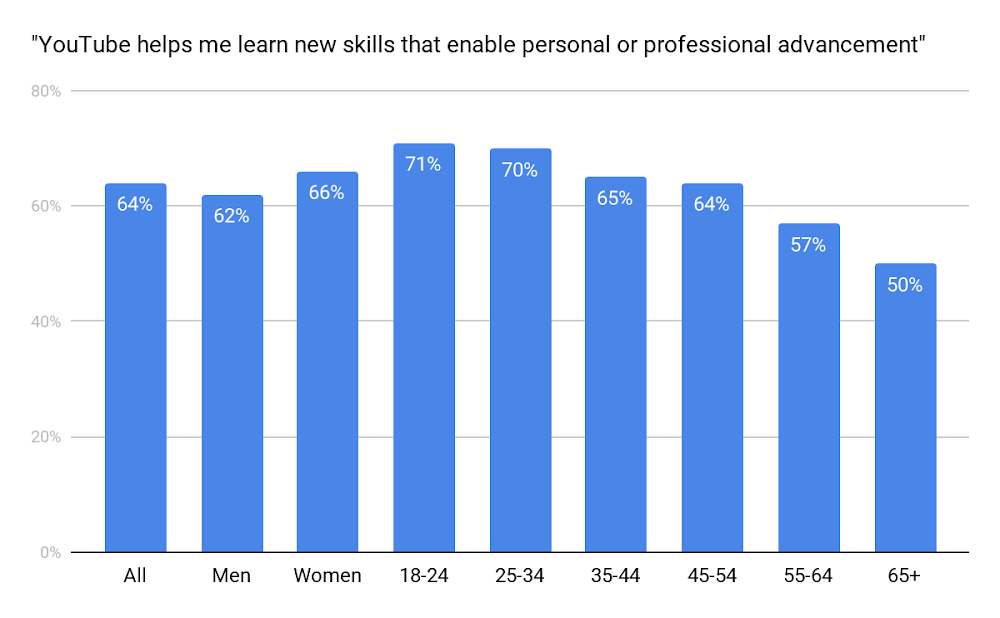
As part of the research, we ran interviews with people who note that YouTube is a key resource for learning and building their career. One respondent in Saudi Arabia observed that: “YouTube makes me feel like I have a teacher—a teacher that’s available at any moment.” Likewise, a teenager from France, said, “I decided I wanted to work in fashion thanks to YouTube. I learned how to apply makeup and spot fashion trends thanks to what I learned from YouTubers.”
No matter if you want to launch your business or find tips to get a new job, YouTube is a resource that’s always there to help you grow. What will you learn next?
No matter if you want to launch your business or find tips to get a new job, YouTube is a resource that’s always there to help you grow. What will you learn next?
From Big Data projects like Strayer University’s student support system to AI projects like Carnegie Mellon’s socially aware robot, researchers are discovering that cloud technology can help make academic research cheaper, faster, easier, and more secure. Whether you’re just starting out with a new idea, or validating your work before sharing it with the public, we want to help you advance your new discoveries. That’s why we’re deepening our support for your biggest questions and best guesses through a new program: Google Cloud Platform (GCP) research credits. Academic researchers in qualified regions are encouraged to apply.
Like the Google Cloud Platform Education Grants to support computer science courses and the partnership to support National Science Foundation (NSF) grants in BIGDATA, our GCP research credits program supports faculty who want to take advantage of GCP’s data storage, analytics, and machine-learning capabilities. Andrew V. Sutherland, a computational number theorist and Principal Research Scientist at the Massachusetts Institute of Technology, is one of a growing number of academic researchers who have already made the transition and benefited from GCP. His team moved the L-Functions and Modular Forms Database to GCP because “we are mathematicians who want to focus on our research, and not have to worry about hardware failures or scaling issues with the website.”
Other researchers are taking advantage of GCP’s scalable infrastructure. Ryan Abernathey, Assistant Professor of Earth and Environmental Sciences, Ocean and Climate Physics at the Lamont-Doherty Earth Observatory at Columbia University, used Google Cloud credits through an NSF partnership and, with his team, developed an open-source platform to manage the complex data sets of climate science. The platform, called Pangeo, can run Earth System Modeling simulations on petabytes of high-resolution, three-dimensional data. “This is the future of what day-to-day science research computing will look like,” he predicts.
At the Stanford Center for Genomics and Personalized Medicine (SCGPM), researchers using GCP and BigQuery can now run hundreds of genomes through a variant analysis pipeline and get query results quickly. Mike Snyder, director of SCGPM, notes, “We’re entering an era where people are working with thousands or tens of thousands or even million genome projects, and you’re never going to do that on a local cluster very easily. Cloud computing is where the field is going.”
Googlers like Fei-Fei Li, Chief Scientist for Cloud AI and ML, are excited to be able to support important research through the new avenue of the credits program: “As an academic, I’m thrilled that Google Cloud will make GCP credits available to the research community. This will help support important scientific discoveries and accelerate fundamental research that are critical for the future.”
The GCP research credits program is open to faculty doing cutting-edge research in eligible countries. We’re eager to hear how we can help accelerate your progress. If you’re interested, you can learn more on our FAQ or apply now.
Like the Google Cloud Platform Education Grants to support computer science courses and the partnership to support National Science Foundation (NSF) grants in BIGDATA, our GCP research credits program supports faculty who want to take advantage of GCP’s data storage, analytics, and machine-learning capabilities. Andrew V. Sutherland, a computational number theorist and Principal Research Scientist at the Massachusetts Institute of Technology, is one of a growing number of academic researchers who have already made the transition and benefited from GCP. His team moved the L-Functions and Modular Forms Database to GCP because “we are mathematicians who want to focus on our research, and not have to worry about hardware failures or scaling issues with the website.”
Other researchers are taking advantage of GCP’s scalable infrastructure. Ryan Abernathey, Assistant Professor of Earth and Environmental Sciences, Ocean and Climate Physics at the Lamont-Doherty Earth Observatory at Columbia University, used Google Cloud credits through an NSF partnership and, with his team, developed an open-source platform to manage the complex data sets of climate science. The platform, called Pangeo, can run Earth System Modeling simulations on petabytes of high-resolution, three-dimensional data. “This is the future of what day-to-day science research computing will look like,” he predicts.
At the Stanford Center for Genomics and Personalized Medicine (SCGPM), researchers using GCP and BigQuery can now run hundreds of genomes through a variant analysis pipeline and get query results quickly. Mike Snyder, director of SCGPM, notes, “We’re entering an era where people are working with thousands or tens of thousands or even million genome projects, and you’re never going to do that on a local cluster very easily. Cloud computing is where the field is going.”
Googlers like Fei-Fei Li, Chief Scientist for Cloud AI and ML, are excited to be able to support important research through the new avenue of the credits program: “As an academic, I’m thrilled that Google Cloud will make GCP credits available to the research community. This will help support important scientific discoveries and accelerate fundamental research that are critical for the future.”
The GCP research credits program is open to faculty doing cutting-edge research in eligible countries. We’re eager to hear how we can help accelerate your progress. If you’re interested, you can learn more on our FAQ or apply now.
In Google Earth’s Voyager, we’ve climbed aboard the ISS, simulated eclipses, and gone deep into the Amazon. Now, with the help of our friends at Atlas Obscura, we're adding something new to the mix. In a multiple choice quiz, Atlas Obscura takes you to some of the most beautiful—and intriguing—places on the planet. Know where Morning Glory Pool is? Or the hot springs of Dallol? See how well you know your planet, and explore these places in Google Earth. If you get stuck, look out for a hint or two on Twitter.
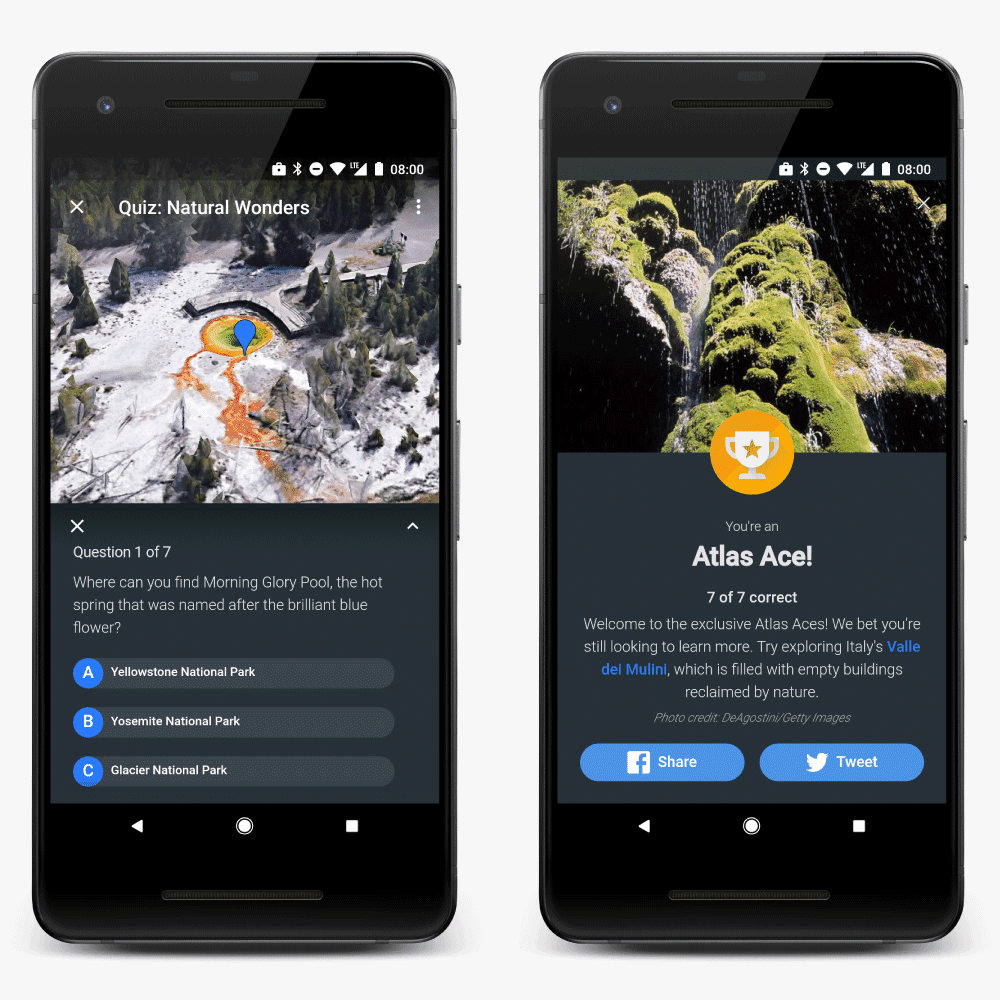
Coming up: We don't know about you, but we're hearing royal wedding bells. Check back in Google Earth mid-May to test your knowledge of magnificent castles and palaces around the world.
Email is a necessity for most of us. We use it to stay in touch with colleagues and friends, keep up with the latest news, manage to-dos at home or at work—we just can’t live without it. Today we announced major improvements to Gmail on the web to help people be more productive at work. Here’s a quick look at how the new Gmail can help you accomplish more from your inbox.
Do more without leaving your inbox
Gmail’s new look helps you get more done. Click on attachments—like photos—without opening or scrolling through large conversations, use the new snooze button to put off emails that you just can’t get to right now or easily access other apps you use often, like Google Calendar, Tasks (now available on Android and iOS) and Keep.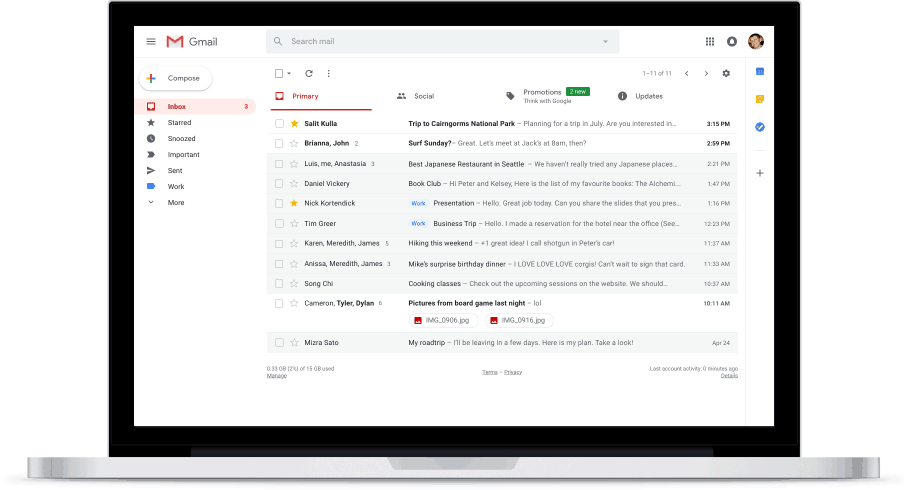
Gmail will also “nudge” you to follow up and respond to messages with quick reminders that appear next to your email messages to help make sure nothing slips through the cracks.

We’re also adding Smart Reply to Gmail on the web to help you reply to messages faster.
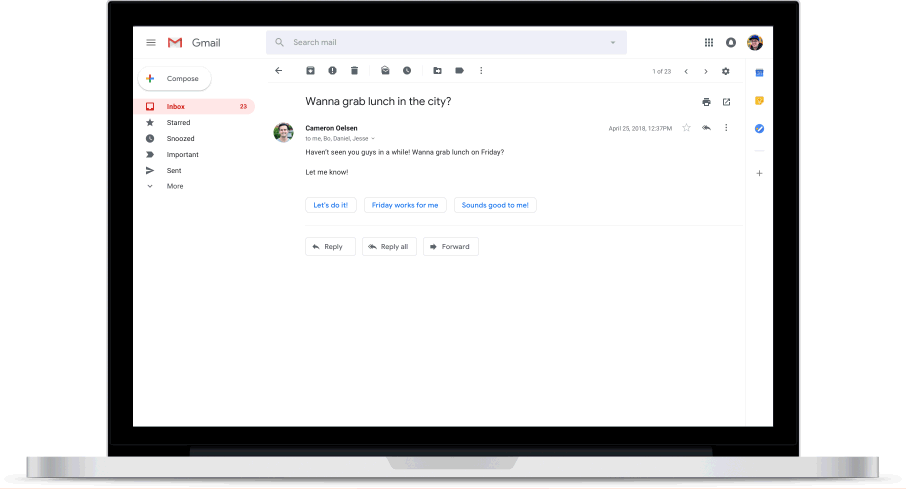
New features on mobile, like high-priority notifications, can notify you of important messages to help you stay focused without interruption. Plus, Gmail will start suggesting when to unsubscribe from newsletters or offers you no longer care about.
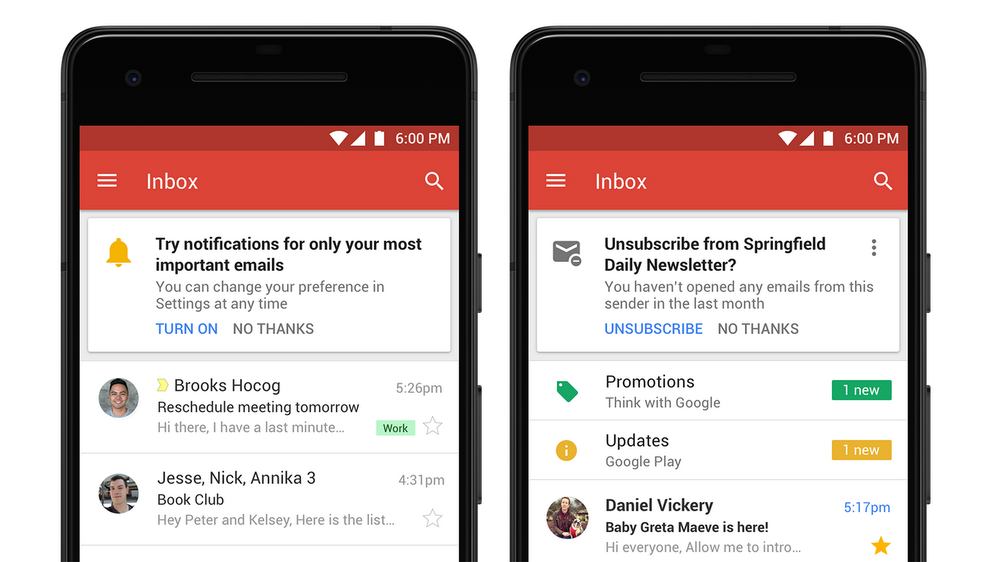
And you might notice new warnings in Gmail that alert you when potentially risky email comes through.

Finally, a new confidential mode allows you to remove the option to forward, copy, download or print messages—useful for when you have to send sensitive information via email like a tax return or your social security number. You can also make a message expire after a set period of time to help you stay in control of your information.
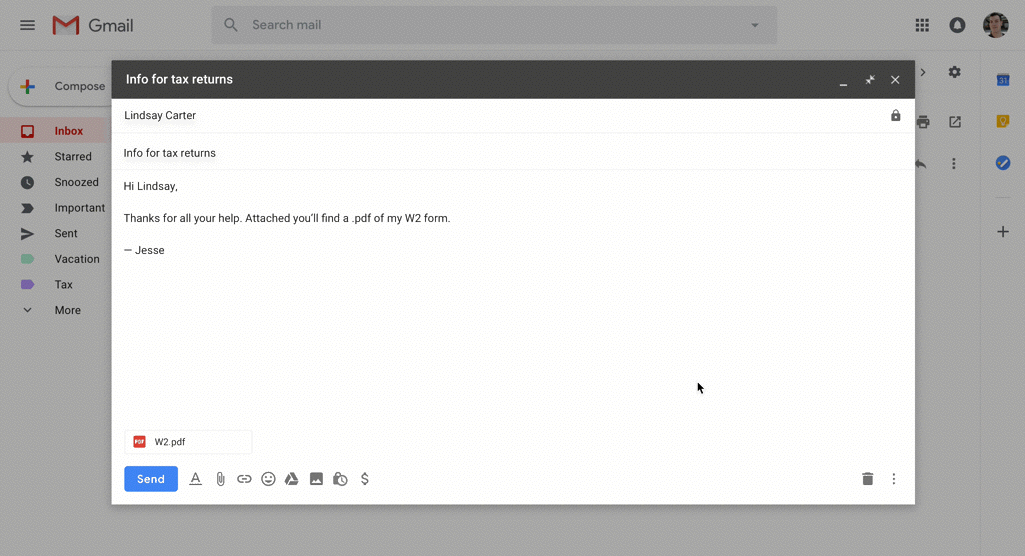
Get started
You can start using these new updates in Gmail on the web today, with some features appearing within the coming weeks. Go to Settings (the cog wheel in the top right corner of your inbox) and select “Try the new Gmail.” If you want to switch back later down the road, you can go to the same place and select “Go back to classic Gmail.” This handy product guide can help you get started.If you’re interested in learning more about how you can use Gmail in the workplace, check out our G Suite post which has more detail on all of the ways Gmail can help you stay productive.
Since the beginning, our aim with G Suite has been to help companies transform the way they work with our suite of cloud-based collaboration and productivity apps.
Today we’re announcing major updates to help the more than 4 million paying businesses that use G Suite work safer, smarter and more efficiently. This includes an all-new Gmail, with a brand new look on the web, advanced security features, new applications of Google’s artificial intelligence and even more integrations with other G Suite apps. We’re also introducing a new way to manage work on the go with Tasks.
Keeping your data secure is our top priority, which is why last month, we introduced new phishing protections to help address Business Email Compromise (BEC) threats—or when someone impersonates an executive to get sensitive information. With these new protections, Gmail has helped block 99.9 percent of BEC attempts by warning users or automatically moving messages to spam for them.
Today, we’re introducing a new approach to information protection: Gmail confidential mode. With confidential mode, it’s possible to protect sensitive content in your emails by creating expiration dates or revoking previously sent messages. Because you can require additional authentication via text message to view an email, it’s also possible to protect data even if a recipient’s email account has been hijacked while the message is active.
Today we’re announcing major updates to help the more than 4 million paying businesses that use G Suite work safer, smarter and more efficiently. This includes an all-new Gmail, with a brand new look on the web, advanced security features, new applications of Google’s artificial intelligence and even more integrations with other G Suite apps. We’re also introducing a new way to manage work on the go with Tasks.
Keep sensitive data secure with new Gmail security features
Keeping your data secure is our top priority, which is why last month, we introduced new phishing protections to help address Business Email Compromise (BEC) threats—or when someone impersonates an executive to get sensitive information. With these new protections, Gmail has helped block 99.9 percent of BEC attempts by warning users or automatically moving messages to spam for them.
Today, we’re introducing a new approach to information protection: Gmail confidential mode. With confidential mode, it’s possible to protect sensitive content in your emails by creating expiration dates or revoking previously sent messages. Because you can require additional authentication via text message to view an email, it’s also possible to protect data even if a recipient’s email account has been hijacked while the message is active.

New confidential mode in Gmail lets you set expiration dates for sensitive information.
Built-in Information Rights Management (IRM) controls also allow you to remove the option to forward, copy, download or print messages. This helps reduce the risk of confidential information being accidentally shared with the wrong people. Confidential mode will begin to roll out to consumer Gmail users and a limited number of G Suite customers in the coming weeks (broader rollout following).
We’ve also redesigned our security warnings within Gmail so that they are simpler to understand and give a clear call to action to employees. These bigger, bolder warnings will help you be even more informed when it comes to potentially risky email.
We’ve also redesigned our security warnings within Gmail so that they are simpler to understand and give a clear call to action to employees. These bigger, bolder warnings will help you be even more informed when it comes to potentially risky email.
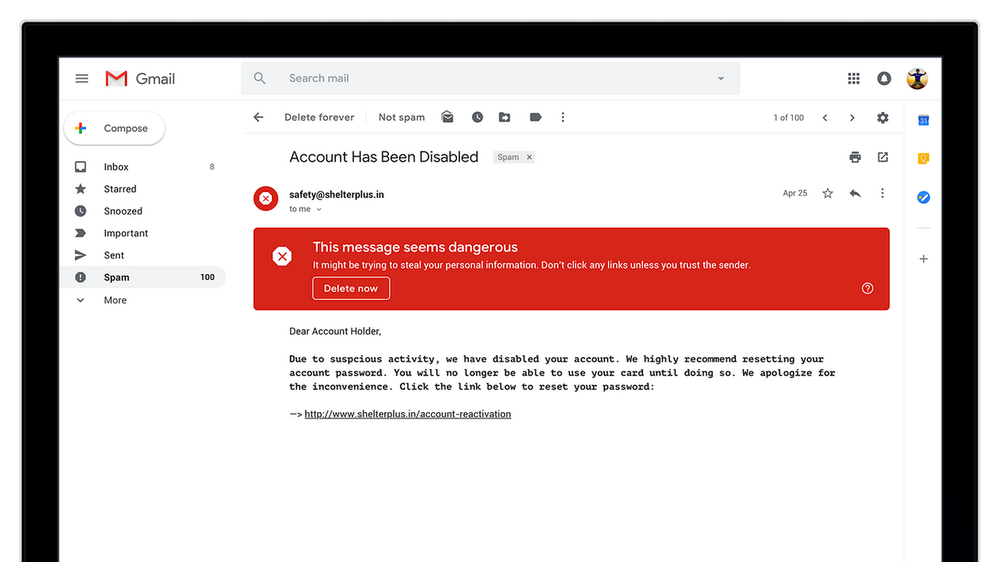
Bigger, bolder security warnings help you keep your company’s confidential information safe.
And it’s always worth a reminder: we do not scan Gmail for the purposes of targeting ads, and there are no ads shown in Gmail for G Suite customers.
Most of us get more emails than we can deal with at one time, and sometimes things slip through the cracks. With Nudging, Gmail will proactively remind you to follow up or respond to messages, making sure you don’t drop the ball.
Stay on top of email effortlessly using artificial intelligence in Gmail
New AI-powered features in Gmail, like Nudging, Smart Reply and high-priority notifications, can now help you spend more time on work that matters.Most of us get more emails than we can deal with at one time, and sometimes things slip through the cracks. With Nudging, Gmail will proactively remind you to follow up or respond to messages, making sure you don’t drop the ball.
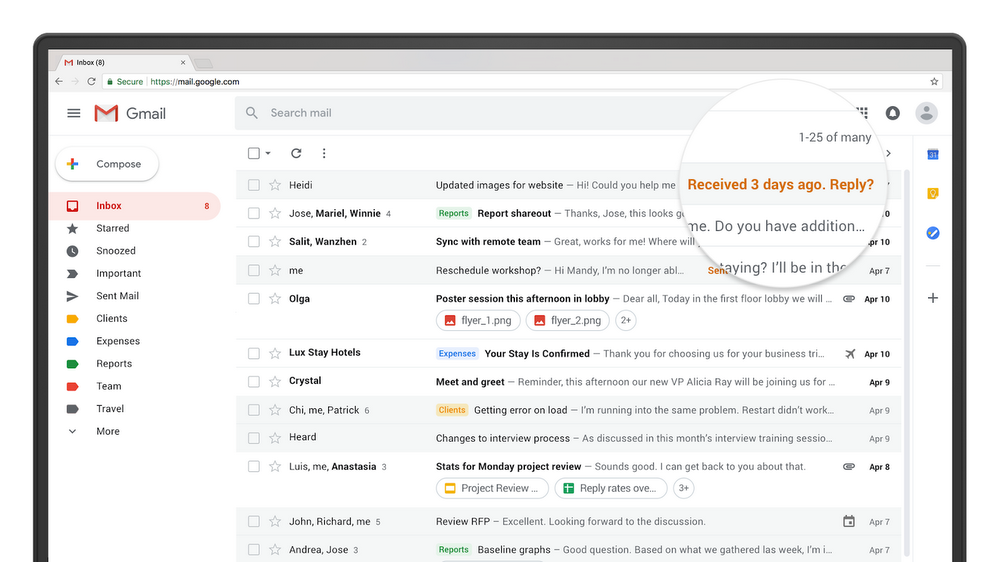
Now Gmail will intelligently (and subtly) “nudge” you when you need to prioritize actions in your inbox.
Last year, we introduced Smart Reply to our Gmail mobile apps. Smart Reply processes hundreds of millions of messages daily and already drives more than 10 percent of email replies on mobile. Today we’re bringing Smart Reply to Gmail on the web to help you respond to messages faster.
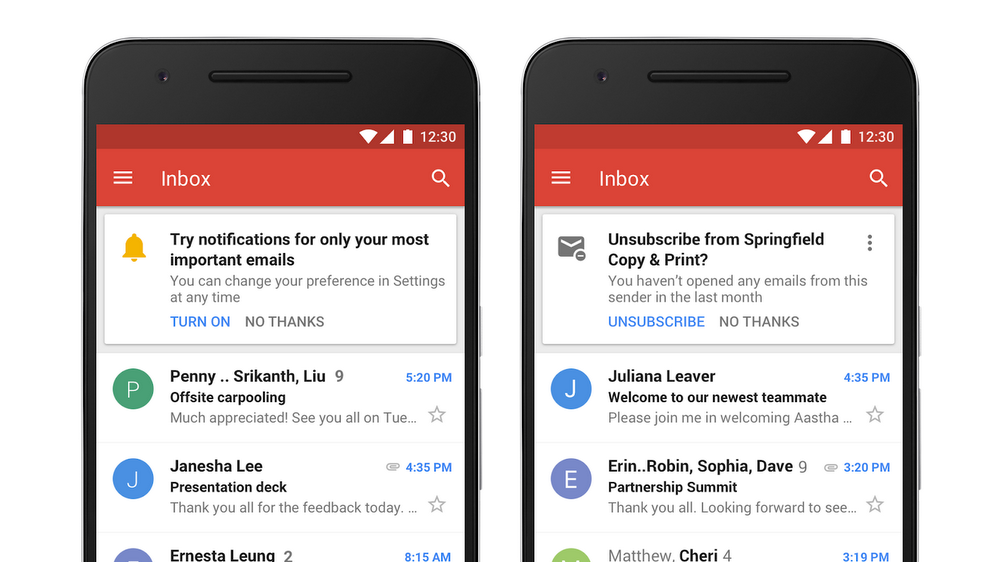
New notifications on mobile help you stay focused on what’s important (and eliminate clutter, too.).
We’re also introducing new features on mobile to help you minimize interruptions and clutter. High-priority notifications is a new setting that only notifies you of important messages, keeping interruptions to a minimum. Gmail can also recommend when to unsubscribe from mailing lists. Using intelligence, unsubscribe suggestions appear based on cues like how many emails you get from a sender and how many of them you actually read. You’ll start to see these notifications show up in your inbox over the coming weeks.
Over the past few months, Salesforce has tested the new Gmail to collaborate on global projects. “As the global leader in CRM, the ability to quickly and securely communicate with our stakeholders around the world is critical,” says Jo-ann Olsovsky, executive vice president and chief information officer of Salesforce. “Gmail’s new easy-to-use interface and built-in intelligence enable our employees to collaborate faster and smarter, spending less time managing their inboxes and more time driving our customers’ success.”
Over the past few months, Salesforce has tested the new Gmail to collaborate on global projects. “As the global leader in CRM, the ability to quickly and securely communicate with our stakeholders around the world is critical,” says Jo-ann Olsovsky, executive vice president and chief information officer of Salesforce. “Gmail’s new easy-to-use interface and built-in intelligence enable our employees to collaborate faster and smarter, spending less time managing their inboxes and more time driving our customers’ success.”
Gmail’s new easy-to-use interface and built-in intelligence enable our employees to collaborate faster and smarter.
Accomplish more from your inbox with easy-to-use tools
We redesigned the Gmail web application to help you take action even quicker. Now you can see and click attachments in your inbox before ever opening a thread. You can also hover over messages (you don’t have to click into them) to do things like RSVP to a meeting invite, archive an email thread or snooze an email until the time is right.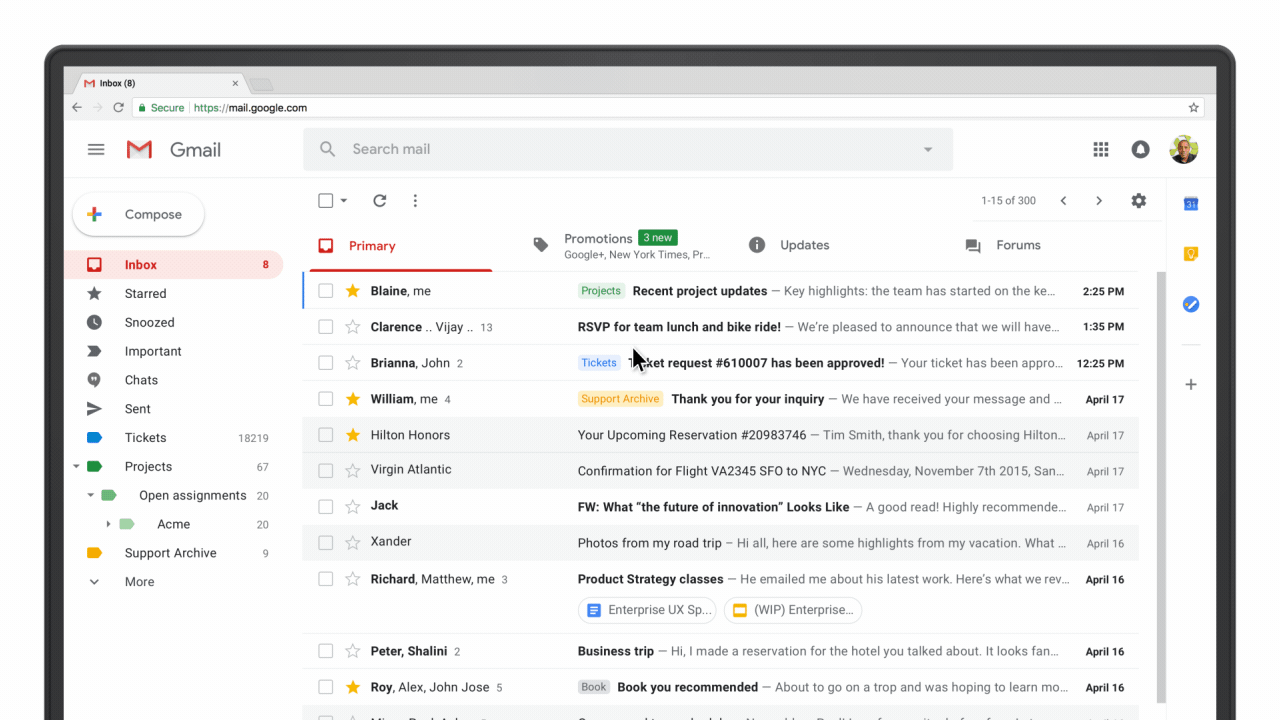
Gmail’s new design helps you take action quicker.
As a part of the redesign, we’re also tightly integrating Gmail with other G Suite apps you use every day. Now you can quickly reference, create or edit Calendar invites, capture ideas in Keep or manage to-dos in Tasks all from a side panel in your inbox.
The side panel also makes it easy to access Gmail Add-ons, too, like third-party business apps you might use. This way you don’t have to switch between tabs or apps to get work done. You’ll start to see the new side panel integration in other G Suite apps in coming months—like inside of your Calendar, Docs, Sheets and Slides apps.
The side panel also makes it easy to access Gmail Add-ons, too, like third-party business apps you might use. This way you don’t have to switch between tabs or apps to get work done. You’ll start to see the new side panel integration in other G Suite apps in coming months—like inside of your Calendar, Docs, Sheets and Slides apps.
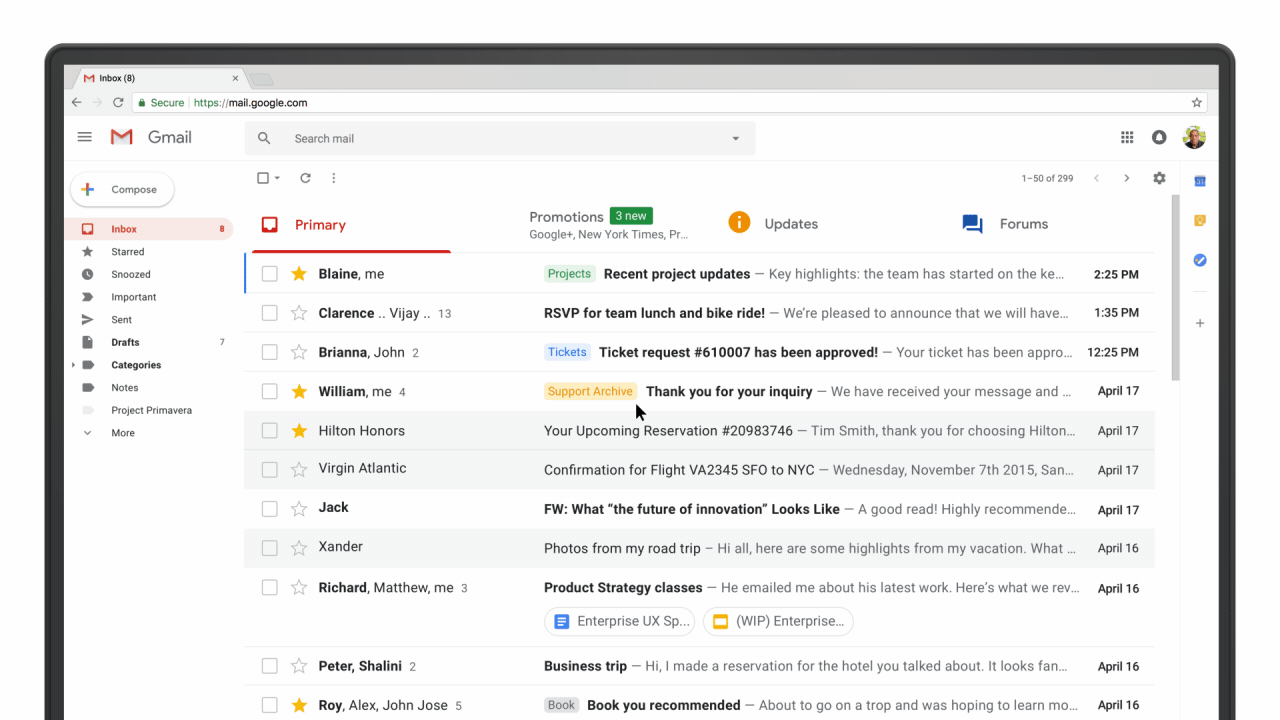
Use the new side panel in Gmail to access all of your favorite G Suite apps, like Google Calendar.
New native offline capabilities in Gmail on the web can help you work without interruption when you can’t find Wi-Fi. Search, write, respond, delete, or archive up to 90 days of messages, just as you would working online, but offline. Teams can start using offline capabilities in coming weeks.
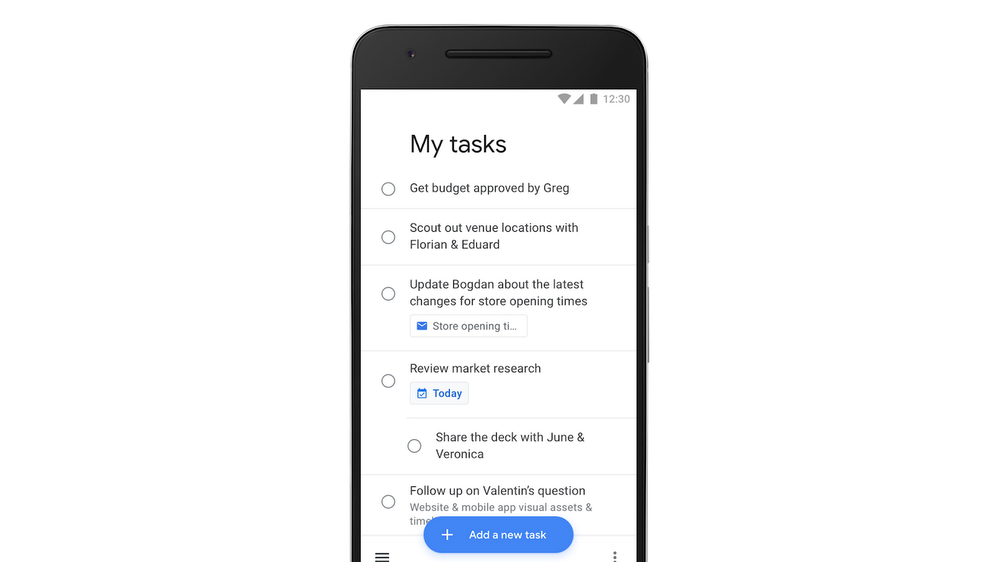
Track projects and meet deadlines with Tasks’ refreshed design on the web and brand new mobile apps.
Like we mentioned, we’re introducing an all-new Tasks on web, as well as new mobile apps to help you handle work on the go. You can use Tasks to create tasks and subtasks, and even add due dates with notifications to help you stay on track.
And because Tasks closely integrates with G Suite, you can simply drag and drop an email from Gmail into Tasks to create a to-do. Tasks with due dates can also appear in your Calendar. You can download the new Tasks mobile apps from the Google Play Store or iOS App Store today.
And because Tasks closely integrates with G Suite, you can simply drag and drop an email from Gmail into Tasks to create a to-do. Tasks with due dates can also appear in your Calendar. You can download the new Tasks mobile apps from the Google Play Store or iOS App Store today.
The all-new Gmail experience is available for businesses to start using today in the G Suite Early Adopter Program (EAP) and can be turned on in the Admin console. Read more detail on how to turn on the experience in this post. Heads up: you’ll start to see offline support, confidential mode (limited release), Nudging, high-priority notifications and unsubscribe suggestions appear in the coming weeks. Keep up with the latest news on these features in the G Suite Updates blog.
Personal Gmail users can opt-in to the new experience, too (Go to Settings in the top right and select “Try the new Gmail.”).
Finally, if you need help getting started with the new Gmail, check out this Help Center article or this cheat sheet on our Learning Center.
Personal Gmail users can opt-in to the new experience, too (Go to Settings in the top right and select “Try the new Gmail.”).
Finally, if you need help getting started with the new Gmail, check out this Help Center article or this cheat sheet on our Learning Center.
We're deeply concerned by the opioid crisis that has impacted families in every corner of the United States. We started by thinking about how to bring Google’s technical expertise to help families combat the epidemic.
Research by the federal government has shown that prescription drug abuse is a large driver of opioid addiction, and that the majority of abused prescription drugs are obtained from family or friends, often from a home medicine cabinet. The U.S. Drug Enforcement Administration (DEA) has found that one way that Americans can help prevent drug abuse and addiction is to properly dispose of unneeded or expired prescription drugs. Yet many people aren’t aware of, or can’t easily find, prescription drug disposal programs in their communities.
Using Google Maps API, our team worked with the DEA to create a locator tool for the National Prescription Drug Take Back Day this Saturday, April 28. The locator tool can help anyone find a place near them to safely dispose of leftover prescription medications. Click on the image below to access the locator, and enter an address or zip code to find nearby Take Back Day events this Saturday and help fight the opioid epidemic.
Research by the federal government has shown that prescription drug abuse is a large driver of opioid addiction, and that the majority of abused prescription drugs are obtained from family or friends, often from a home medicine cabinet. The U.S. Drug Enforcement Administration (DEA) has found that one way that Americans can help prevent drug abuse and addiction is to properly dispose of unneeded or expired prescription drugs. Yet many people aren’t aware of, or can’t easily find, prescription drug disposal programs in their communities.
Using Google Maps API, our team worked with the DEA to create a locator tool for the National Prescription Drug Take Back Day this Saturday, April 28. The locator tool can help anyone find a place near them to safely dispose of leftover prescription medications. Click on the image below to access the locator, and enter an address or zip code to find nearby Take Back Day events this Saturday and help fight the opioid epidemic.
Longer term, we’re working with the DEA and state governments like Iowa, Arizona, Massachusetts, and Michigan to gather data on year-round take back options for future Google Maps integration.
In addition to making it easier to find take back locations, we’re also proud to support non-profit organizations on the frontlines of this crisis. We’ve worked with the Partnership for Drug-Free Kids since 2015 to help parents searching online for support connect to the Partnership’s Parent Helpline. This service provides free counseling and advice to parents who need help addressing the many challenges of a child’s substance use. Today, we’re announcing $750,000 in matching grants from Google.org to help expand the Parent Helpline and get even more families the support and help they need.
In addition to making it easier to find take back locations, we’re also proud to support non-profit organizations on the frontlines of this crisis. We’ve worked with the Partnership for Drug-Free Kids since 2015 to help parents searching online for support connect to the Partnership’s Parent Helpline. This service provides free counseling and advice to parents who need help addressing the many challenges of a child’s substance use. Today, we’re announcing $750,000 in matching grants from Google.org to help expand the Parent Helpline and get even more families the support and help they need.
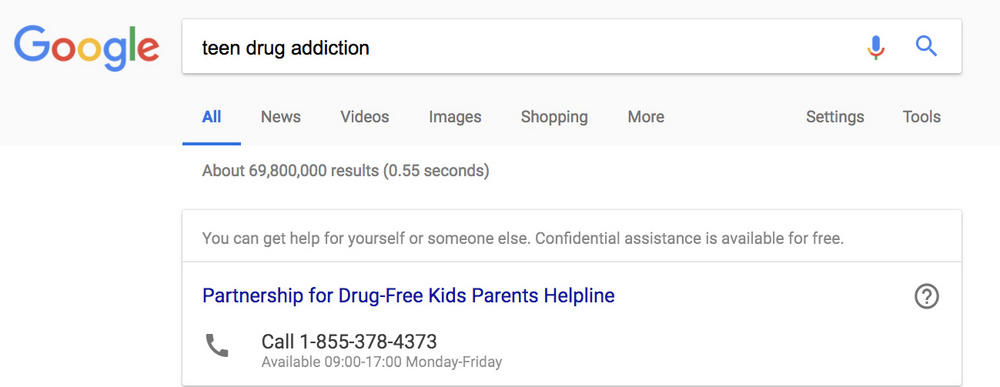
We’re also committed to ensuring that the public understands the danger of opioid abuse and the resources available for those who need help, by making useful information about opioid addiction and prescription drugs available in Google Search.
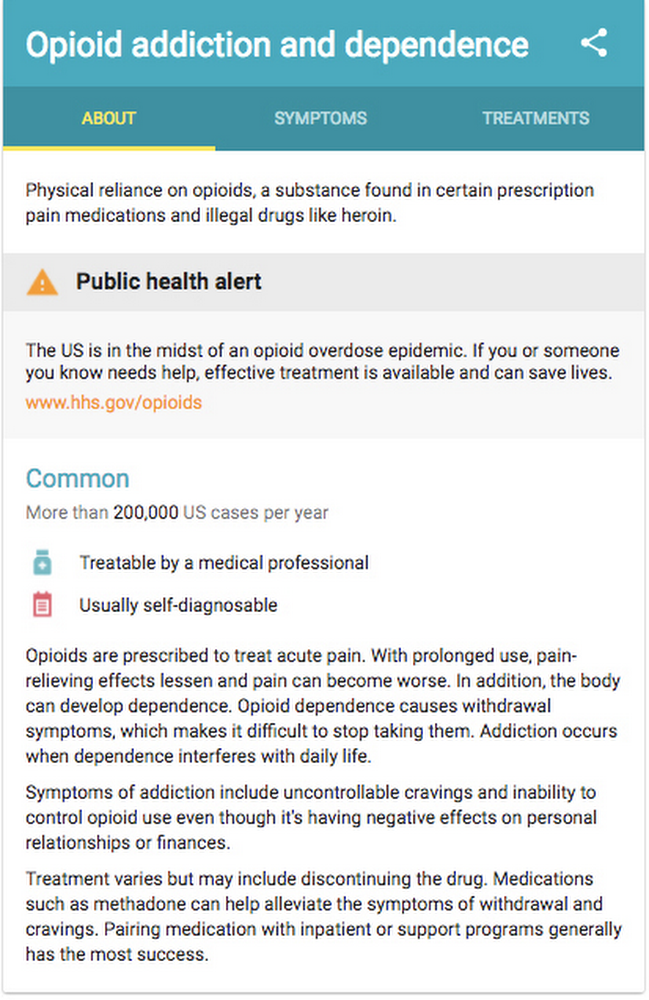
There are no easy answers to a challenge as large as the opioid crisis, but we’re committed to doing our part to ensure that people in every corner of the country have access to the resources they need to address this urgent public health emergency.
Editor’s Note:This post comes from Cynthia Fernandes, Principal at Hall School in Bridgeport, Connecticut.
For the past three years, sixth graders at my school have learned about architecture and design through an extracurricular program started by Thom Mayne, founder of the architecture firm Morphosis and winner of the Pritzker Prize. It’s been amazing to see 10- and 11-year-olds talking about angles, form, and design—and do it with confidence. Though they’re only in elementary school, the students do work at the level of middle- or high-schoolers. This year, they've used Google Pixelbook to create an accurate 3D model of their classroom, and then build on the model with abstract installations of their own design. We recently took a few minutes to hear from the students about their experience.
Q: What’s your favorite part about this class? What have you learned?
Miguel: I like creating things and showing them to other people. The part I love the most is talking about my creations—what do they mean? What do they say?
Milayna: My favorite part is when we do hands-on stuff, like models or drawings. I like this because it’s fun and I’m always proud of my work. I’m crafty.
Q: What’s a cool vocabulary word you learned about in this class? What does it mean?
Zamair: My favorite vocabulary word is “disarrange.” That means to put stuff in places so it’s not arranged.
Milayna: A cool vocabulary word is “suspended,” because it sounds cool, and it means hanging from the ceiling.
Shayla: My favorite word is “surround,” because you can make a cool model, than surround it with other, smaller or bigger, cool models.
Yalidsa: “Hierarchy.” It means the order of things, like different shapes and shades, what’s thick and thin, what’s heavy and light.
Q: Have you learned anything in this class that you use in other classes?
Milayna: I learned how to look at buildings differently, and that helps me because in social studies we are studying old buildings, so it fits in perfectly.
Zamair: I use architecture in math, with area and volume.
Q: What was your proudest moment in this class?
Kania: My proudest moment was when I did a great job on my presentation on my architecture project.
Miguel: My proudest moment was when a lot of people came in to see our projects, and we had to discuss them. I was the first to go up and speak, and everybody liked what I was saying, and that made me feel proud.
Q: If you were an architect, what would you want to make?
Yalidsa: My own clothing or toy shop.
Kania: I’d want to design my own house for me and my family.
Ernesto: A school or office building.
Joel: I’d want to make something that will make people's life easier.
Hasan: I’d build an airplane that’s beautiful. And that can go up in the air by itself.
Miguel: I’d want to make an office that would make everybody stop and think, “How did that person get that idea to make this?” It would probably be tall and have, like, a yellow shine to it when the sunset comes. The outside would most likely have a pattern on each wall, white and glowing.
Clinton: A big house with a pool and a football field and a basketball court.
Q: What’s it like to work with classmates on projects?
Clinton: It’s cool because I work with my friends, and it’s fun working with your friends.
Miguel: Working with classmates is cool because, when you have no idea of what to do, other people can help you out and give you more ideas. Working together is good because you can make something that was way better than you thought it would be.
Erik: It feels like you can do better work, since you’re working together and helping each other.
Q: What do you tell your friends about this program?
Joel: I tell my friends how cool this program is, and how we’re so lucky to be doing this.
Hasan: I tell them that it is a great program, and it’s what I might do when I grow up.
Q: What’s your favorite part about this class? What have you learned?
Miguel: I like creating things and showing them to other people. The part I love the most is talking about my creations—what do they mean? What do they say?
Milayna: My favorite part is when we do hands-on stuff, like models or drawings. I like this because it’s fun and I’m always proud of my work. I’m crafty.
Q: What’s a cool vocabulary word you learned about in this class? What does it mean?
Zamair: My favorite vocabulary word is “disarrange.” That means to put stuff in places so it’s not arranged.
Milayna: A cool vocabulary word is “suspended,” because it sounds cool, and it means hanging from the ceiling.
Shayla: My favorite word is “surround,” because you can make a cool model, than surround it with other, smaller or bigger, cool models.
Yalidsa: “Hierarchy.” It means the order of things, like different shapes and shades, what’s thick and thin, what’s heavy and light.
Q: Have you learned anything in this class that you use in other classes?
Milayna: I learned how to look at buildings differently, and that helps me because in social studies we are studying old buildings, so it fits in perfectly.
Zamair: I use architecture in math, with area and volume.
Q: What was your proudest moment in this class?
Kania: My proudest moment was when I did a great job on my presentation on my architecture project.
Miguel: My proudest moment was when a lot of people came in to see our projects, and we had to discuss them. I was the first to go up and speak, and everybody liked what I was saying, and that made me feel proud.
Q: If you were an architect, what would you want to make?
Yalidsa: My own clothing or toy shop.
Kania: I’d want to design my own house for me and my family.
Ernesto: A school or office building.
Joel: I’d want to make something that will make people's life easier.
Hasan: I’d build an airplane that’s beautiful. And that can go up in the air by itself.
Miguel: I’d want to make an office that would make everybody stop and think, “How did that person get that idea to make this?” It would probably be tall and have, like, a yellow shine to it when the sunset comes. The outside would most likely have a pattern on each wall, white and glowing.
Clinton: A big house with a pool and a football field and a basketball court.
Q: What’s it like to work with classmates on projects?
Clinton: It’s cool because I work with my friends, and it’s fun working with your friends.
Miguel: Working with classmates is cool because, when you have no idea of what to do, other people can help you out and give you more ideas. Working together is good because you can make something that was way better than you thought it would be.
Erik: It feels like you can do better work, since you’re working together and helping each other.
Q: What do you tell your friends about this program?
Joel: I tell my friends how cool this program is, and how we’re so lucky to be doing this.
Hasan: I tell them that it is a great program, and it’s what I might do when I grow up.
From Northeastern University’s work to map the spread of the Zika virus, to MIT’s massive computing for theoretical mathematics, higher education institutions are applying cloud technologies to help solve the global challenges we face.
Northeastern and MIT’s work are just two examples of higher education institutions using Google Cloud Platform (GCP) to uncover important insights from massive, diverse data sets. Today, we’re announcing how we’re collaborating with two higher education organizations, Unizin and Internet2, so that their members can benefit from GCP.
The Unizin Data Platform allows institutions to anonymize, aggregate, store, share, and analyze teaching and learning data. Member universities use this data to do things like identify students who may be at risk of failing a class or improve personalized learning approaches. Understanding data from the past gives educators more insights and tools to help improve student outcomes.
Rob Lowden, Unizin Executive Director, shared that "Building the Unizin Data Platform on the Google Cloud Platform provides our members with scalable infrastructure, powerful data analytics and the ability to leverage machine learning solutions to advance Unizin's work to improve learning research and outcomes in a highly secure environment. Google Cloud is an ideal provider for Unizin to advance the higher education digital learning ecosystem."
We hope these new collaborations will help more institutions take advantage of Google Cloud Platform to drive impact in research and collaboration. To learn more visit our website or express interest.
Northeastern and MIT’s work are just two examples of higher education institutions using Google Cloud Platform (GCP) to uncover important insights from massive, diverse data sets. Today, we’re announcing how we’re collaborating with two higher education organizations, Unizin and Internet2, so that their members can benefit from GCP.
Improving student outcomes through the Unizin Data Platform
Colleges and universities are constantly seeking ways to better understand and help their students. This week Unizin, a consortium of 25 leading universities working together to improve education with technology, announced that its Unizin Data Platform (UDP) will be built on Google Cloud Platform as part of a new alliance with Google Cloud.The Unizin Data Platform allows institutions to anonymize, aggregate, store, share, and analyze teaching and learning data. Member universities use this data to do things like identify students who may be at risk of failing a class or improve personalized learning approaches. Understanding data from the past gives educators more insights and tools to help improve student outcomes.
Rob Lowden, Unizin Executive Director, shared that "Building the Unizin Data Platform on the Google Cloud Platform provides our members with scalable infrastructure, powerful data analytics and the ability to leverage machine learning solutions to advance Unizin's work to improve learning research and outcomes in a highly secure environment. Google Cloud is an ideal provider for Unizin to advance the higher education digital learning ecosystem."
GCP now available to the Internet2 community
Founded in 1996, the nonprofit consortium Internet2 provides a collaborative environment for U.S. research and education organizations to solve shared technology challenges. Internet2 has announced that member institutions can now use Google Cloud Platform, available through distributor Carahsoft, to develop solutions in support of their educational, research and community service missions. The pre-Validation service is available now and the fully validated service will launch later this year. Institutions can learn more and express interest on Internet2's website.We hope these new collaborations will help more institutions take advantage of Google Cloud Platform to drive impact in research and collaboration. To learn more visit our website or express interest.
The student with big dreams, some education, and no experience. The accomplished service professional looking to break into a new field. The 30-year career veteran who wants to work for another 20 years. Research has shown that up to one-third of Americans may need to develop new skills to work in different types of jobs by 2030. A fast-changing economy means we need new ways of building new skills and translating existing skills to different types of meaningful work. This goes not only for how we get new jobs, but how we get promoted, change fields, and work into our later years.
To get this transition right, businesses, nonprofits, governments, and communities will have to work together to build a system that benefits both workers and employers. That’s why Walmart and Google—among the world’s leading retail and technology companies, respectively—are coming together to fuel the research and tools needed to build such a system.
Each of our companies has launched major initiatives to help Americans advance in their careers. Walmart has made a significant investment in its associates and through philanthropy to help transform learning and advancement in the retail sector. And through Grow with Google, Google has made a major commitment to helping people access skills and opportunity in the new economy. Through these initiatives, we are joining forces with leading social innovators to fuel the pursuit of a more equitable and efficient labor market.
Today, as part of our commitment toward jobs and opportunity, Walmart and Google are making a $5 million grant investment to three organizations testing solutions in reskilling the American workforce and matching skills to roles.
The Drucker Institute will be partnering with the Mayor of South Bend, Indiana, to integrate the city’s educational and workforce resources so that every resident has access to skill-building throughout their careers—this “City of Lifelong Learning” will serve as a national model. Opportunity @ Work will help underserved groups connect to jobs and advancement opportunities by building a hiring channel that focuses on skills and competency instead of pedigree. And the MIT Initiative on the Digital Economy will be expanding its Inclusive Innovation Challenge, a global future of work prize that promotes entrepreneurs harnessing technology to create more broadly shared economic opportunity and prosperity.
No one organization can do this alone, and that’s why collaboration between companies and expert groups is so important. As companies like ours help enable social innovators to try new things and see what works, we hope to see more philanthropic collaboration, along with effort from policy makers to scale proven programs. And we encourage other companies to join in similar efforts, through investing in training and education for their own workforce or in the broader workforce ecosystem to help build strong businesses and a healthy, thriving society.
This is a time of enormous change for our economy and we need to better prepare American workers—from students to seniors—to find work and advance their careers. Only a system that is both ambitious and resilient can meet the demands of millions of workers eager to expand their skills and advance. We’re excited to see what these grantees, and other innovators across industries, do to help.
To get this transition right, businesses, nonprofits, governments, and communities will have to work together to build a system that benefits both workers and employers. That’s why Walmart and Google—among the world’s leading retail and technology companies, respectively—are coming together to fuel the research and tools needed to build such a system.
Each of our companies has launched major initiatives to help Americans advance in their careers. Walmart has made a significant investment in its associates and through philanthropy to help transform learning and advancement in the retail sector. And through Grow with Google, Google has made a major commitment to helping people access skills and opportunity in the new economy. Through these initiatives, we are joining forces with leading social innovators to fuel the pursuit of a more equitable and efficient labor market.
Today, as part of our commitment toward jobs and opportunity, Walmart and Google are making a $5 million grant investment to three organizations testing solutions in reskilling the American workforce and matching skills to roles.
The Drucker Institute will be partnering with the Mayor of South Bend, Indiana, to integrate the city’s educational and workforce resources so that every resident has access to skill-building throughout their careers—this “City of Lifelong Learning” will serve as a national model. Opportunity @ Work will help underserved groups connect to jobs and advancement opportunities by building a hiring channel that focuses on skills and competency instead of pedigree. And the MIT Initiative on the Digital Economy will be expanding its Inclusive Innovation Challenge, a global future of work prize that promotes entrepreneurs harnessing technology to create more broadly shared economic opportunity and prosperity.
No one organization can do this alone, and that’s why collaboration between companies and expert groups is so important. As companies like ours help enable social innovators to try new things and see what works, we hope to see more philanthropic collaboration, along with effort from policy makers to scale proven programs. And we encourage other companies to join in similar efforts, through investing in training and education for their own workforce or in the broader workforce ecosystem to help build strong businesses and a healthy, thriving society.
This is a time of enormous change for our economy and we need to better prepare American workers—from students to seniors—to find work and advance their careers. Only a system that is both ambitious and resilient can meet the demands of millions of workers eager to expand their skills and advance. We’re excited to see what these grantees, and other innovators across industries, do to help.
We’ve all seen lots of articles about the future of work in today’s rapidly changing economy. Too often, the loudest voices propose just one of two visions for the future. Either globalization and technology will eliminate quality jobs, or we'll adapt to change just like we always have.
Google may be built on code, but we don't believe the future is binary. What lies ahead is hard to predict, and the most likely scenario for the future of work is a new sort of hybrid—with technology both transforming and creating jobs and new models of employment. But we’re confident that, working together, we can shape a labor market where everyone has access to opportunity.
Last year, we launched Grow with Google, an initiative that aims to help everyone across America access the best of Google’s training and tools to grow their skills, careers, and businesses. Google Hire helps employers find great employees. And Google for Jobs helps job seekers find new opportunities.
But making a difference requires more than just one company. Today, as part of our commitment to jobs and opportunity, Walmart and Google are making a $5 million grant investment to three organizations testing solutions in reskilling the American workforce and matching skills to roles.
These grants are part of Google.org’s Work Initiative, a search for new solutions to prepare people for the changing nature of work. Last year, we committed $50 million to nonprofits experimenting with new ideas in skill-building, job matching, job quality, and social protections. In response to an open call for proposals, we received hundreds of ideas from across the U.S. In addition to our joint funding with Walmart, today we’re announcing four more grantees:
Through these new grants, we aim to back leading social innovators’ thinking about how work can help more people access not just income, but also purpose and meaning. Over the next several months, we’ll be announcing more grantees, and, most importantly, sharing what Google and all our grantees are learning through these efforts.
Google may be built on code, but we don't believe the future is binary. What lies ahead is hard to predict, and the most likely scenario for the future of work is a new sort of hybrid—with technology both transforming and creating jobs and new models of employment. But we’re confident that, working together, we can shape a labor market where everyone has access to opportunity.
Last year, we launched Grow with Google, an initiative that aims to help everyone across America access the best of Google’s training and tools to grow their skills, careers, and businesses. Google Hire helps employers find great employees. And Google for Jobs helps job seekers find new opportunities.
But making a difference requires more than just one company. Today, as part of our commitment to jobs and opportunity, Walmart and Google are making a $5 million grant investment to three organizations testing solutions in reskilling the American workforce and matching skills to roles.
- Learning throughout life: The Drucker Institute is partnering with the Mayor of South Bend, Indiana, to bring together the city’s educational and workforce resources so that everyone has access to skill-building throughout their careers. This “City of Lifelong Learning” will serve as a national model for communities looking to make learning available throughout life.
- Improving matching between skills and roles: Opportunity@Work is launching the techhire.careers platform, a new tool that helps underserved groups validate their skills for employers and connect to opportunities. This inclusive hiring marketplace helps job seekers and entry-level workers connect to trainings and jobs that make best use of their skills, and helps companies consider and hire nontraditional talent.
- Backing social innovators with new skilling and job matching ideas:MIT’s Initiative on the Digital Economy is holding the Inclusive Innovation Challenge, a challenge for social innovators to use technology to reinvent the future of work. Through this tournament, the IDE will be seeking out and funding social innovators experimenting with new ways of helping people develop the skills they need for the digital economy and connect to job opportunities in a new way.
These grants are part of Google.org’s Work Initiative, a search for new solutions to prepare people for the changing nature of work. Last year, we committed $50 million to nonprofits experimenting with new ideas in skill-building, job matching, job quality, and social protections. In response to an open call for proposals, we received hundreds of ideas from across the U.S. In addition to our joint funding with Walmart, today we’re announcing four more grantees:
- Assessing and credentialing soft skills:Southern New Hampshire University is developing the Authentic Assessment Platform (AAP), an assessment of in-demand soft skills. Results from this assessment will feed into a job placement process for young jobseekers. SNHU will provide those who complete this assessment with an SNHU official badge.
- Training workers for the gig economy:Samaschool is developing a new training, with both in-person and online components, that helps independent workers learn the basics of finding freelance work, building their careers, managing contracts and taxes, and more.
- Helping communities adjust to workforce transitions: Just Transition Fund is working with communities in coal country to develop a blueprint for coal-affected communities undergoing workforce transitions, helping them to effectively prepare for jobs in emerging sectors.
- Aiding employers in clearly signaling their needs:The U.S. Chamber of Commerce Foundation is developing new and open resources to help those who hire to better convey their needs. These tools will include new standards on job descriptions, a digital library of open-sourced competency and credential resources, and a repository of job descriptions for benchmarking.
Through these new grants, we aim to back leading social innovators’ thinking about how work can help more people access not just income, but also purpose and meaning. Over the next several months, we’ll be announcing more grantees, and, most importantly, sharing what Google and all our grantees are learning through these efforts.
Over the next few weeks people will start locking in their summer travel plans—we see the biggest spike in Google Flights searches for summer vacation dates in early May. And since prices often rise in the three weeks prior to travel dates, you’ll want to start your research ahead of time. Here are some tips to help you decide where to go—and find the best flights and places to stay—wherever your travels may take you.
Pick your summer hotspot
Since the FIFA World Cup starts in June in Russia, Moscow and St. Petersburg top the list of popular places to visit this summer. If soccer’s not your thing, then Vietnam, Tanzania and Malaysia are other trending international destinations. In the U.S., Hawaii continues to be a top pick for summer travelers, and places like Providence and Santa Fe are rising in popularity.
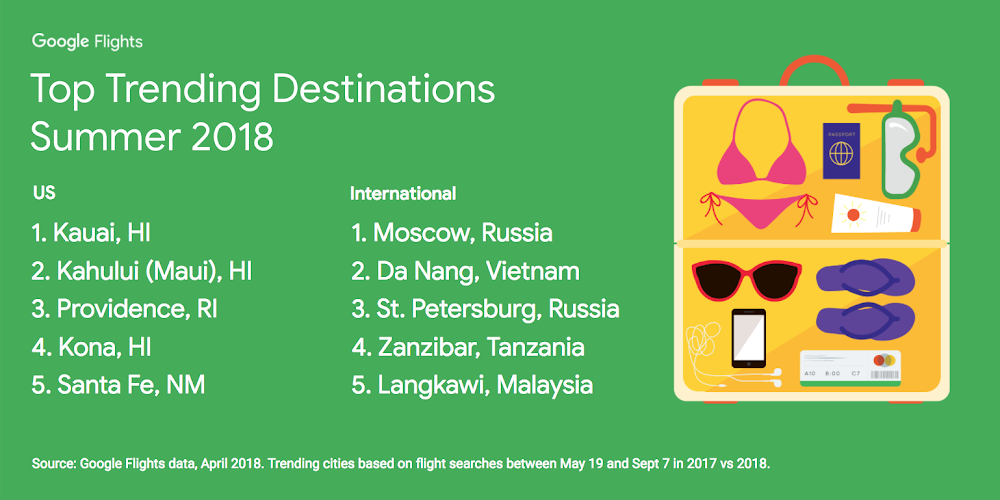
To find out more about the city you’re interested in, you can search for “Things to do” and you’ll see a list of top sights plus articles with helpful travel advice. Our machine learning models determine the most relevant, high-quality travel articles for your destination, like activities to do with children and where to shop.
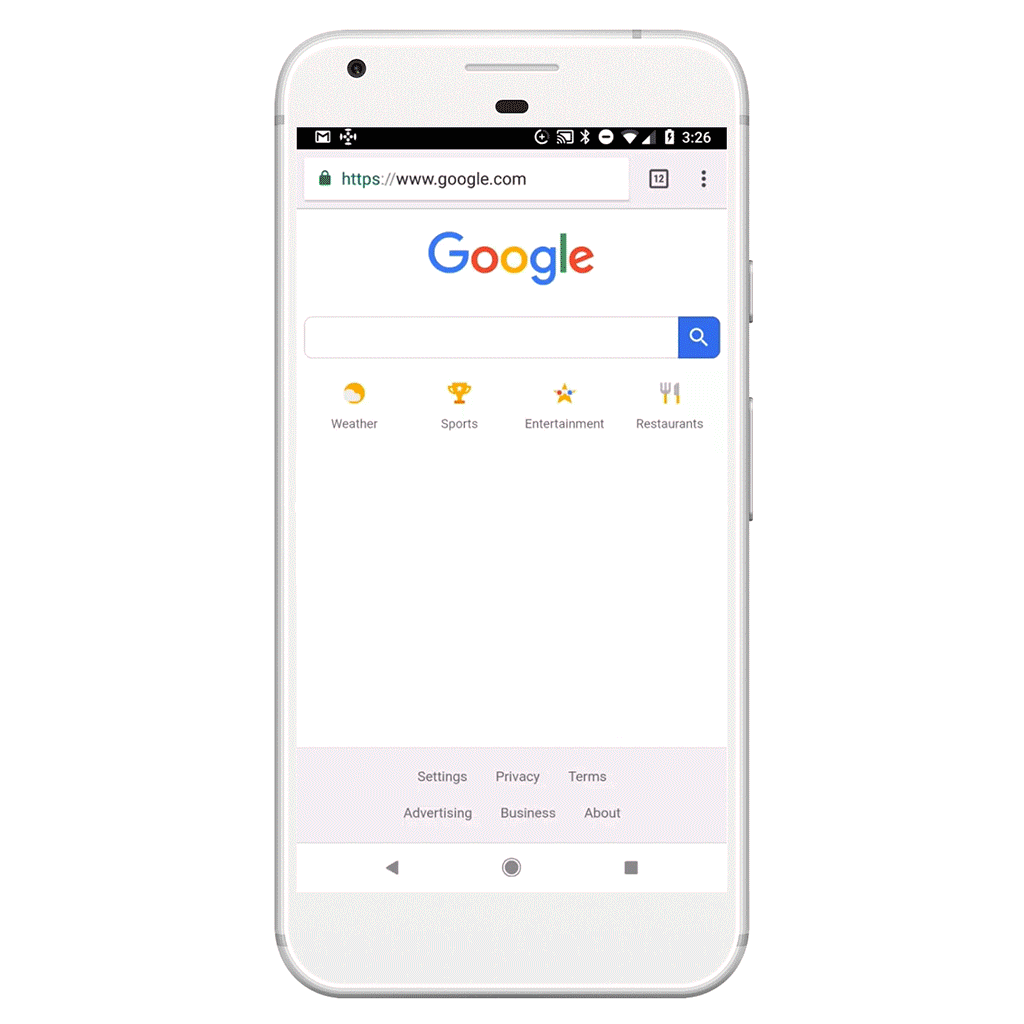
Find the best flights (and prices) to meet your needs
Once you’ve got a place in mind, you can find the best flights using the recently redesigned Google Flights. A simpler home screen and search experience on desktop—combined with flight price insights showing the cheapest dates to fly, alternate airport options to help you save money, and other tips all in one place—make it easier to make the right flight choice quickly.
Once you’ve got a place in mind, you can find the best flights using the recently redesigned Google Flights. A simpler home screen and search experience on desktop—combined with flight price insights showing the cheapest dates to fly, alternate airport options to help you save money, and other tips all in one place—make it easier to make the right flight choice quickly.
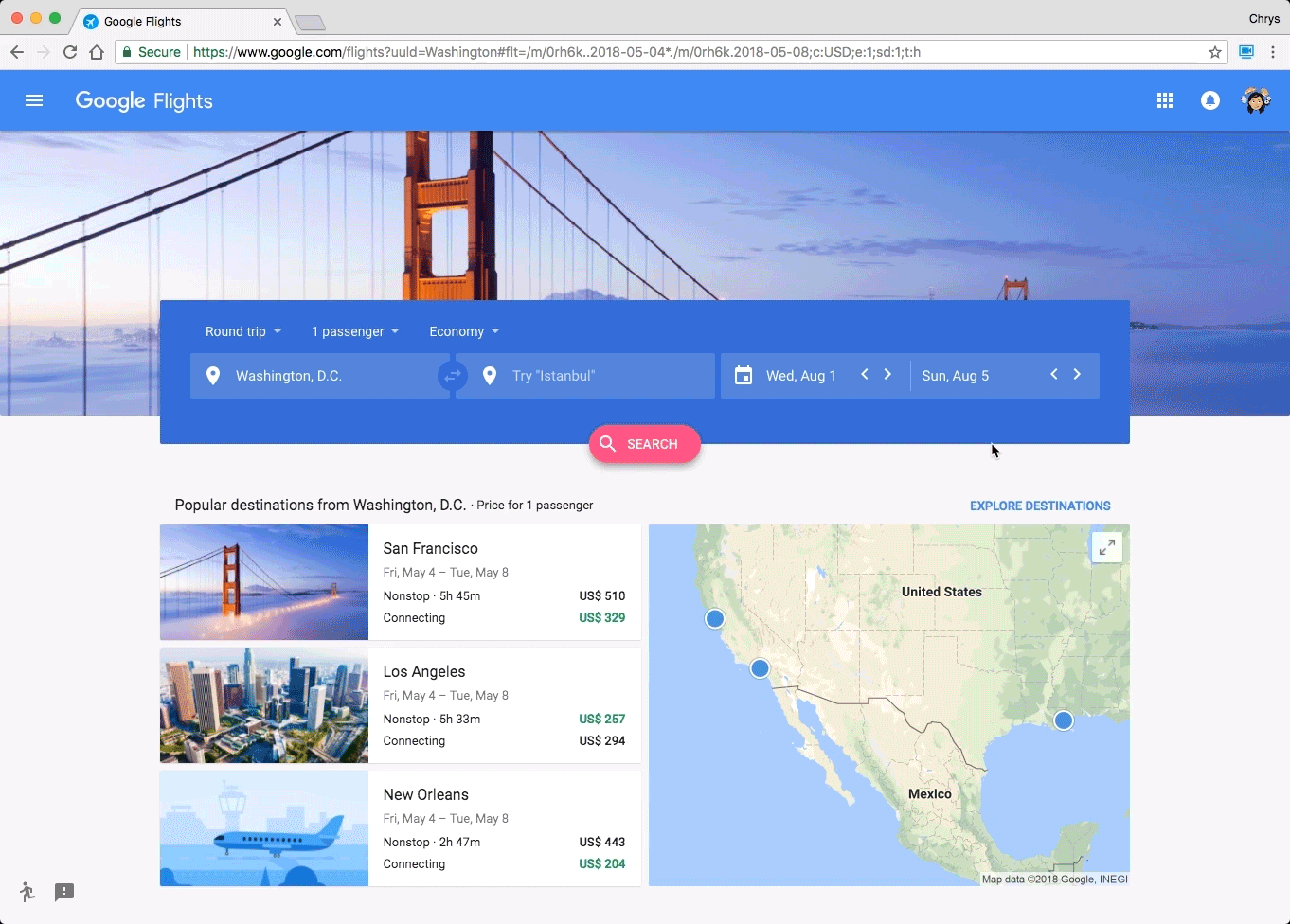
Now that some flight fares don’t include carry-on luggage fees, it can be tricky to know what’s included in the ticket prices you’re looking at. Earlier this year, we made it possible to see what’s included in Basic Economy fares in the U.S. when you select a ticket for airlines like American, United and Delta. To see only ticket prices that include access to overhead bins—and help you compare similar ticket types—we’ve added a “Bags” filter. This filter is now available for U.S. flights and will roll out to itineraries outside the U.S. in the next few months.
Spot hotel deals and tips quickly
To help you find the right hotel, we’re using machine learning and statistical analysis of historical hotel data and reviews to organize and surface the most relevant hotel information.
In the “Hotels” tab, you’ll be tipped off if you’re getting a room rate that’s lower than normal or, similar to the feature in Google Flights, shifting your itinerary a few days earlier may save you money. When you’re ready, you can select bed type, see add-ons like free breakfast, and book a room.
Spot hotel deals and tips quickly
To help you find the right hotel, we’re using machine learning and statistical analysis of historical hotel data and reviews to organize and surface the most relevant hotel information.
In the “Hotels” tab, you’ll be tipped off if you’re getting a room rate that’s lower than normal or, similar to the feature in Google Flights, shifting your itinerary a few days earlier may save you money. When you’re ready, you can select bed type, see add-ons like free breakfast, and book a room.
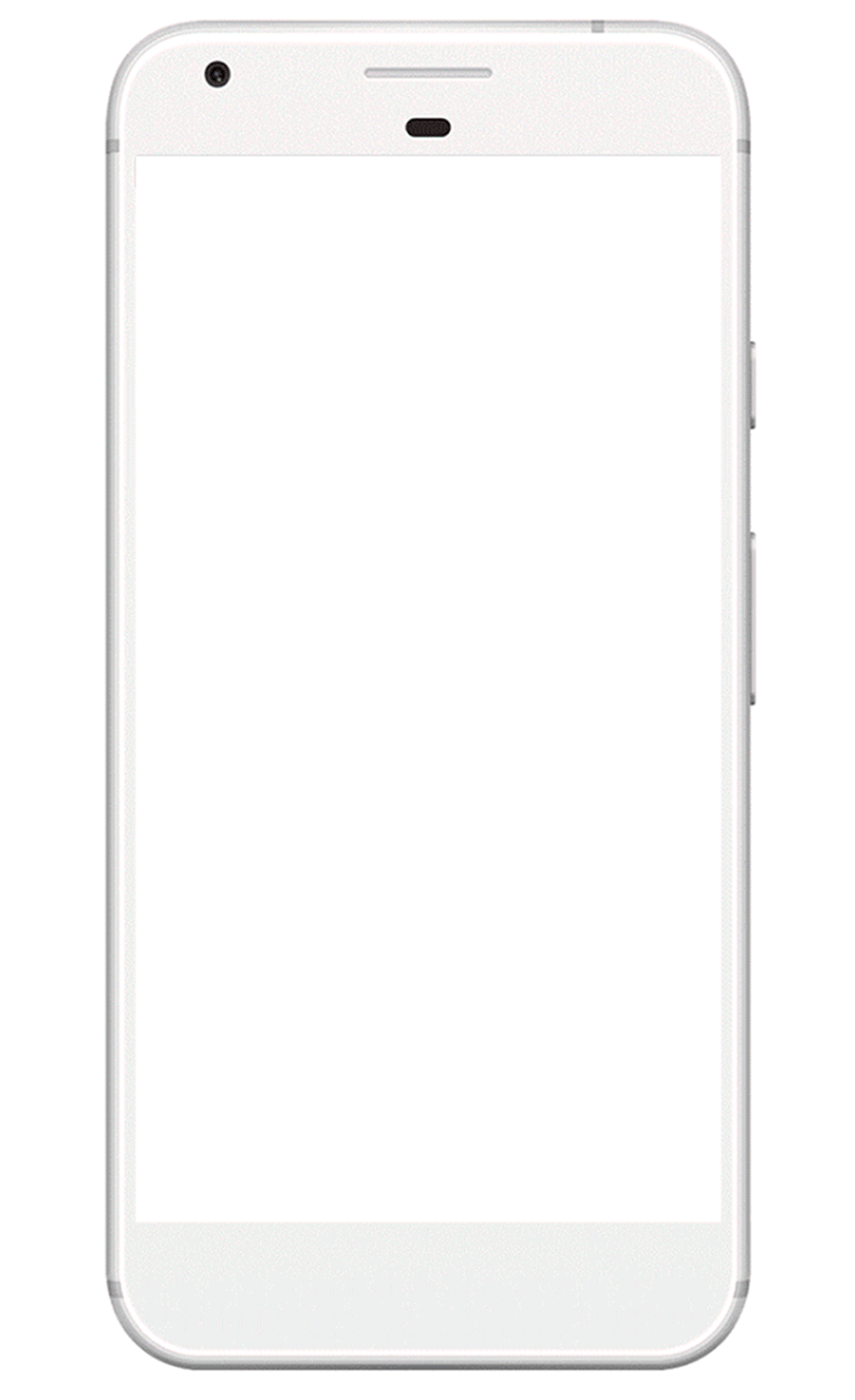
In December, we took the Street View trekker to Christmas Island, a remote tropical territory of Australia just south of Indonesia. With Parks Australia, we joined the island’s red crabs as they marched in the millions from the forest to the sea for their annual migration.
Now it’s time to shellebrate. Starting today on Google Maps Street View and Google Earth, you can explore Christmas Island and Cocos (Keeling) Islands’ unique wildlife, dazzling ocean vistas and lush rainforests, including the grand finale of the red crab migration—the spawning. The red crabs wait all year for this very moment—and the precise alignment of the rains, moon and tides—to release their eggs at the coastal waters.
Now it’s time to shellebrate. Starting today on Google Maps Street View and Google Earth, you can explore Christmas Island and Cocos (Keeling) Islands’ unique wildlife, dazzling ocean vistas and lush rainforests, including the grand finale of the red crab migration—the spawning. The red crabs wait all year for this very moment—and the precise alignment of the rains, moon and tides—to release their eggs at the coastal waters.
Christmas Island’s remote location makes it home to a wild and diverse ecosystem—including 600 species of tropical fish, 14 species of terrestrial crabs, more than 100 bird species and four native reptile species. Exploring its wetlands and blowholes and coastline, you can see for yourself why the island is often called “Australia’s Galapagos.”
Christmas Island’s nature and wildlife is so treasured and protected that the crabs have right of way. Roads are often closed during the migration, and Parks Australia have erected fences to direct the crabs to safe crossing points with under-road passes, or fly-over bridges. Now you can join the island’s 45 million red crabs as they crawl along the forest floor, climb the cliffs and finally, spawn at the water’s edge.
Scuttle over to Street View and Google Earth to experience the wonderland of wildlife on Christmas Island and the white sand beaches of Cocos (Keeling) Islands. And as you step into this moment in time, we welcome you to join the crabs as they lead this magnificent dance of nature.
Think about a book that has inspired you, changed your perspective, or made a positive impact on your life. For me, it was “I Know Why the Caged Bird Sings” by Maya Angelou—it spoke to me because she overcame trauma and hardship to become such an influential author and poet.
Today is World Book Day, and Google Play Books can help youfind the next book that’ll make an impact on your life in some way. Here are a few of the World Book Day deals you’ll find on the Play Store:
- "The Novice" by Taran Matharu
- "The Astonishing Color of After" by Emily XR Pan
- "Code Girls" by Liza Mundy
- “The Good Daughter” by Karin Slaughter
15 years ago, I discovered the book that really inspired me. Maybe this World Book Day, Google Play will help you find yours.
Last weekend, fans from all around the world made the trek to Southern California to see some of music’s biggest names perform at Coachella. To make those not at the festival feel like they were there, we headed to the desert with VR180 cameras to capture all the action.
Throughout the first weekend of Coachella, we embarked on one of the largest VR live streams to date, streaming more than 25 performances (with as many cameras to boot) across 20 hours and capturing behind-the-scenes footage of fans and the bands they love. If you missed it live, you can enjoy some of the best experiences—posted here.
VR180 can take you places you never thought possible—the front row at a concert, a faraway travel destination, the finals of your favorite sporting event, or a memorable location. This year at Coachella, we pushed the format even further by adding augmented reality, AR, overlays on top of the performances—like digital confetti that falls when the beat drops, or virtual objects that extend the into the crowd.
Throughout the first weekend of Coachella, we embarked on one of the largest VR live streams to date, streaming more than 25 performances (with as many cameras to boot) across 20 hours and capturing behind-the-scenes footage of fans and the bands they love. If you missed it live, you can enjoy some of the best experiences—posted here.
VR180 can take you places you never thought possible—the front row at a concert, a faraway travel destination, the finals of your favorite sporting event, or a memorable location. This year at Coachella, we pushed the format even further by adding augmented reality, AR, overlays on top of the performances—like digital confetti that falls when the beat drops, or virtual objects that extend the into the crowd.

AR Confetti in the VR180 stream.
To add these overlays in real time, we used our VR180 cameras together with stitching servers running a custom 3D graphics engine and several positionally tracked cameras. This allowed us to add a layer of spatially relevant visuals to the video feed. Simply put, it's like AR stickers for VR180.
In addition to the responsive AR elements during performances, we also featured Tilt Brush art by artist-in-residence Cesar Ortega, who drew his live impressions of the iconic Coachella landscape at daylight, dusk and night. We then inserted Cesar’s designs into the video stream in VR180 to allow the viewer to see the art.
In addition to the responsive AR elements during performances, we also featured Tilt Brush art by artist-in-residence Cesar Ortega, who drew his live impressions of the iconic Coachella landscape at daylight, dusk and night. We then inserted Cesar’s designs into the video stream in VR180 to allow the viewer to see the art.
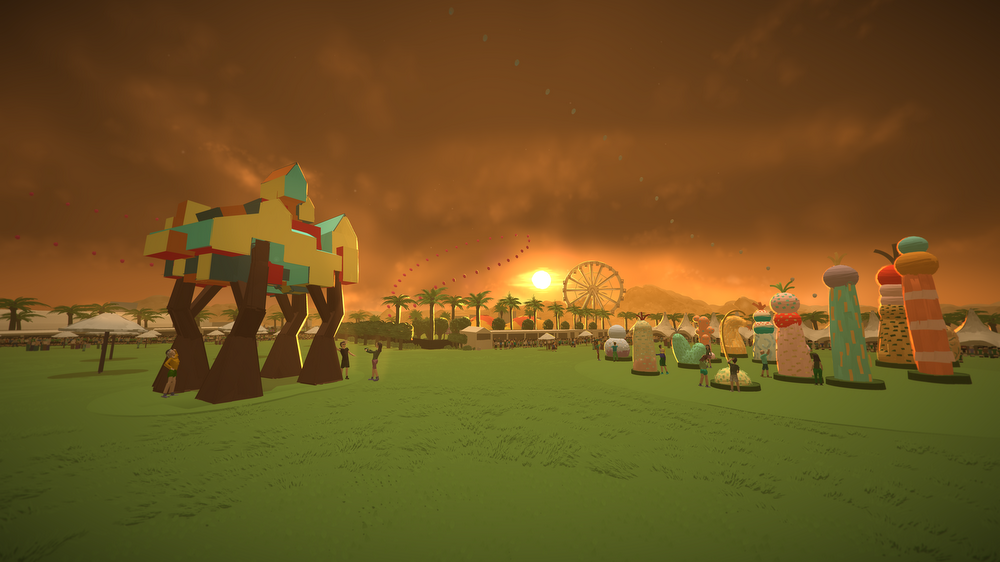
Cesar Ortega’s recreation of Coachella in Tilt Brush
Watch the festival footage, including performances and behind-the-scenes footage from the point of view of both the fans and the bands, here. And for the most immersive experience, check it out in VR with Daydream View or Cardboard.
As the CTO of Etsy, Mike Fisher is responsible for evolving technology strategy, scaling IT systems and infrastructure and deepening machine learning expertise, all of which is crucial to supporting the global creative commerce platform that Etsy is today.
To deliver a buying and selling experience that currently supports approximately 1.9 million entrepreneurs, Mike and his team recently committed to Google Cloud Platform to help them scale and connect Etsy buyers and sellers globally. But their decision was based on more than just technology.
We sat down with Mike to hear about Etsy’s unique approach to evaluating their cloud partner.
QH: Why is sustainability a value at Etsy?
MF: Sustainability supports our mission to Keep Commerce Human, within the company, and outside, to our 1.9 million sellers. It’s an important value that pulls through everything we do; from how we consume food at the office, to the products we help people sell, to how we power our buildings. And of course, it’s important in how we power our data centers, and in the cloud computing we use.
QH: Is this special to Etsy, or is this a broader point about many of today’s companies?
MF: Etsy is a little unique because we've been around almost 13 years, and sustainability has always been core to us. But other businesses are definitely on board. People want to support businesses that are doing this. I think at Google Cloud you've seen that customers want businesses to be able to host and provide their services in a sustainable manner.
QH: True.
MF: They're migrating to the cloud, and having a cloud provider that is committed to that as well is a huge benefit.
QH: In itself, is going to the cloud a business decision around expenditure, or a technology decision over how fast you'll be able to manufacture, test, and deploy software?
MF: I wouldn't separate technology and business decisions. Going to the cloud, for example, is a great business decision for us, since it allows for things like enhanced site performance and focus on our strategic initiatives. We can have a presence around the world, with faster load times. That supports the possibility of stronger conversions and better experiences. You get that with a global cloud. All good for the business. And of course, spinning up infrastructure much, much faster than we could on our own means we’re moving quicker and supporting our sellers’ businesses better.
And then there are the things on the sustainability side. Our servers run 24/7 today in the data center whether we need 100% of their compute capacity or not. But like all of e-commerce, we have daily cycles, monthly cycles, the holiday season. Having to power computers capable of handling our holiday season at peak, instead of scaling up and down for what we need? That is a sustainability decision that is a great business decision.
QH: How do you measure success around sustainable energy consumption?
MF: Our impact goals are economic, social and ecological. Underneath the ecological goal, we want 100% renewable electricity by 2020 -- the offices, and all of the data centers. Google helps that a lot, since you’re committed to 100% renewables. On top of that, we want to reduce the intensity of our energy usage by 25% by 2025, even as we increase our business. It’s pretty hard to imagine doing that without the cloud.
QH: Did you have any differences about your needs working with Google?
MF: We do have differing criteria for renewable energy. We strive to source renewables in the same power market as the consumption, while Google strives to do the same, you also operate in some regions where procuring renewables is complex and may not be possible. But even that was a great conversation, because the Google team worked with us on that. They were like, "we understand that that's important to Etsy, and we will work towards that goal."
QH: Good to know, since I was going to say: Etsy likes handcrafted things, a human touch. But we have thousands of identical servers, and we use lots of automation. They’re not handcrafted Etsy products. But you’re pointing out a human dimension in the engineering work in how our respective engineers talk together.
MF: Even though we love the handmade, we're not up for spinning up all of our servers one at a time, either. We're on board with using Terraform and Chef to automate. There is a huge human connection with the Google reliability engineers sitting beside our engineers. The two of us work together in teams, and that's a big piece of keeping this human and bringing people together.
There’s something else: The more that we can automate, the more we can enable buyers and sellers everywhere to connect. It’s a massive marketplace, with 50 million items and 30 million buyers, but we do it so that one buyer and one seller can actually talk to each other about one particular item. It's really cool that we use a ton of automation on a big cloud to enable really important one-on-one conversations to happen thousands and thousands of times a day.
QH: Maybe it’s a little away from sustainability, but it’s worth saying that the history of IT is the history of taking over drudge work so people can do more human things, be more creative.
MF: Our sellers are entrepreneurs and artisans. They want to be in the studio creating, or talking to a person about their shop. The more that we can help them run the administrative parts of their business in a much faster and automated fashion, the more they can focus on the stuff that is really inventive and creative. That's what they want to do, and we want to get them there faster.
By the way, that’s true on my IT team too. They want to be writing code and optimizing systems, not just applying patches. Say we had to bring in 150 servers; that takes literally months -- two months for us to order the hardware and then receive it on the dock and get it racked and provision it, and install everything that needs to be installed and do that. With the cloud, the other week we spun up the equivalent of 150 servers in four minutes. Then we went back to doing what we want to do and creating software that powers the marketplace.
QH: This has been great. Thank you so much for your time.
Etsy is one of a number of organizations committed to environmental responsibility—many of whom focus on reducing the environmental impact of their operations by reaching 100% renewable energy. Google shares this commitment, and in 2017 we met our own goal of matching 100% of the energy we consume with renewable energy purchases.
Reaching this milestone was very important to us, but it also mattered to many of our customers. Many organizations know that building and expanding on-premises data centers can use a lot of energy from local grids. Our own data centers are no exception, which is why we offset the impact through renewable energy purchases and high quality carbon offsets. So when a Google Cloud customer like Etsy uses our platform, they can rest assured that the net carbon emissions associated with that usage is zero.
Between purchases and offsets, matching energy usage, grids and carbon intensity, it can be tricky to understand the technological aspects of energy. And it’s trickier, still, to understand a company’s strategy for all these things. We’ve launched a newmicrositeto answer these questions, and anyone in the US can use it to view the carbon intensity of their own local grid. We hope this makes it possible for more businesses to understand the environmental impact of their operations.
To deliver a buying and selling experience that currently supports approximately 1.9 million entrepreneurs, Mike and his team recently committed to Google Cloud Platform to help them scale and connect Etsy buyers and sellers globally. But their decision was based on more than just technology.
We sat down with Mike to hear about Etsy’s unique approach to evaluating their cloud partner.
QH: Why is sustainability a value at Etsy?
MF: Sustainability supports our mission to Keep Commerce Human, within the company, and outside, to our 1.9 million sellers. It’s an important value that pulls through everything we do; from how we consume food at the office, to the products we help people sell, to how we power our buildings. And of course, it’s important in how we power our data centers, and in the cloud computing we use.
QH: Is this special to Etsy, or is this a broader point about many of today’s companies?
MF: Etsy is a little unique because we've been around almost 13 years, and sustainability has always been core to us. But other businesses are definitely on board. People want to support businesses that are doing this. I think at Google Cloud you've seen that customers want businesses to be able to host and provide their services in a sustainable manner.
QH: True.
MF: They're migrating to the cloud, and having a cloud provider that is committed to that as well is a huge benefit.
QH: In itself, is going to the cloud a business decision around expenditure, or a technology decision over how fast you'll be able to manufacture, test, and deploy software?
MF: I wouldn't separate technology and business decisions. Going to the cloud, for example, is a great business decision for us, since it allows for things like enhanced site performance and focus on our strategic initiatives. We can have a presence around the world, with faster load times. That supports the possibility of stronger conversions and better experiences. You get that with a global cloud. All good for the business. And of course, spinning up infrastructure much, much faster than we could on our own means we’re moving quicker and supporting our sellers’ businesses better.
And then there are the things on the sustainability side. Our servers run 24/7 today in the data center whether we need 100% of their compute capacity or not. But like all of e-commerce, we have daily cycles, monthly cycles, the holiday season. Having to power computers capable of handling our holiday season at peak, instead of scaling up and down for what we need? That is a sustainability decision that is a great business decision.
QH: How do you measure success around sustainable energy consumption?
MF: Our impact goals are economic, social and ecological. Underneath the ecological goal, we want 100% renewable electricity by 2020 -- the offices, and all of the data centers. Google helps that a lot, since you’re committed to 100% renewables. On top of that, we want to reduce the intensity of our energy usage by 25% by 2025, even as we increase our business. It’s pretty hard to imagine doing that without the cloud.
QH: Did you have any differences about your needs working with Google?
MF: We do have differing criteria for renewable energy. We strive to source renewables in the same power market as the consumption, while Google strives to do the same, you also operate in some regions where procuring renewables is complex and may not be possible. But even that was a great conversation, because the Google team worked with us on that. They were like, "we understand that that's important to Etsy, and we will work towards that goal."
QH: Good to know, since I was going to say: Etsy likes handcrafted things, a human touch. But we have thousands of identical servers, and we use lots of automation. They’re not handcrafted Etsy products. But you’re pointing out a human dimension in the engineering work in how our respective engineers talk together.
MF: Even though we love the handmade, we're not up for spinning up all of our servers one at a time, either. We're on board with using Terraform and Chef to automate. There is a huge human connection with the Google reliability engineers sitting beside our engineers. The two of us work together in teams, and that's a big piece of keeping this human and bringing people together.
There’s something else: The more that we can automate, the more we can enable buyers and sellers everywhere to connect. It’s a massive marketplace, with 50 million items and 30 million buyers, but we do it so that one buyer and one seller can actually talk to each other about one particular item. It's really cool that we use a ton of automation on a big cloud to enable really important one-on-one conversations to happen thousands and thousands of times a day.
QH: Maybe it’s a little away from sustainability, but it’s worth saying that the history of IT is the history of taking over drudge work so people can do more human things, be more creative.
MF: Our sellers are entrepreneurs and artisans. They want to be in the studio creating, or talking to a person about their shop. The more that we can help them run the administrative parts of their business in a much faster and automated fashion, the more they can focus on the stuff that is really inventive and creative. That's what they want to do, and we want to get them there faster.
By the way, that’s true on my IT team too. They want to be writing code and optimizing systems, not just applying patches. Say we had to bring in 150 servers; that takes literally months -- two months for us to order the hardware and then receive it on the dock and get it racked and provision it, and install everything that needs to be installed and do that. With the cloud, the other week we spun up the equivalent of 150 servers in four minutes. Then we went back to doing what we want to do and creating software that powers the marketplace.
QH: This has been great. Thank you so much for your time.
Etsy is one of a number of organizations committed to environmental responsibility—many of whom focus on reducing the environmental impact of their operations by reaching 100% renewable energy. Google shares this commitment, and in 2017 we met our own goal of matching 100% of the energy we consume with renewable energy purchases.
Reaching this milestone was very important to us, but it also mattered to many of our customers. Many organizations know that building and expanding on-premises data centers can use a lot of energy from local grids. Our own data centers are no exception, which is why we offset the impact through renewable energy purchases and high quality carbon offsets. So when a Google Cloud customer like Etsy uses our platform, they can rest assured that the net carbon emissions associated with that usage is zero.
Between purchases and offsets, matching energy usage, grids and carbon intensity, it can be tricky to understand the technological aspects of energy. And it’s trickier, still, to understand a company’s strategy for all these things. We’ve launched a newmicrositeto answer these questions, and anyone in the US can use it to view the carbon intensity of their own local grid. We hope this makes it possible for more businesses to understand the environmental impact of their operations.
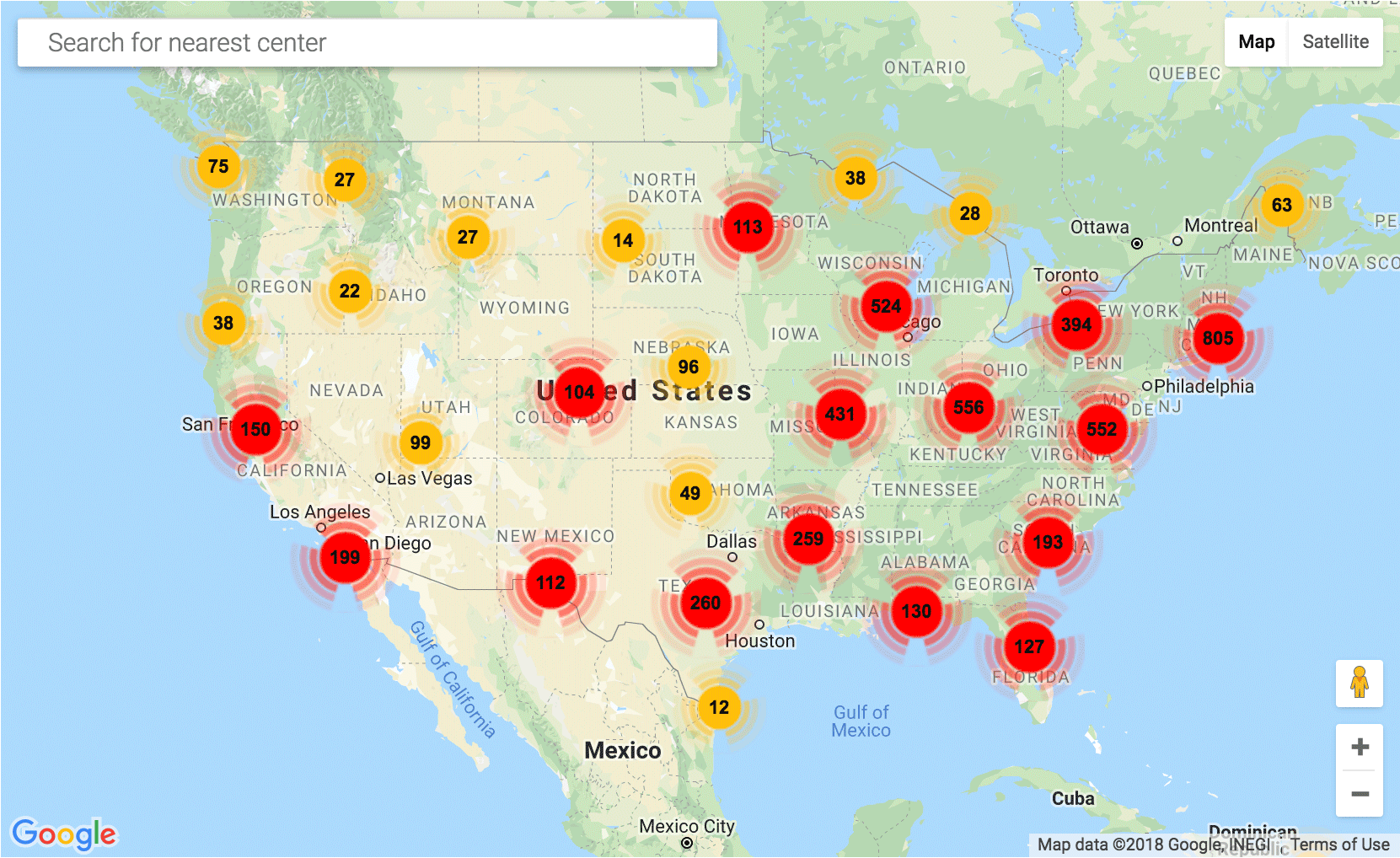
ليست هناك تعليقات:
إرسال تعليق